 |
[ Outlaw Genealogy | Bruce
History | Lost Chords ] [ Projects | News | FAQ | Suggestions | Search | HotLinks | Resources | Ufo ] |
 |
[ Outlaw Genealogy | Bruce
History | Lost Chords ] [ Projects | News | FAQ | Suggestions | Search | HotLinks | Resources | Ufo ] |
Utlage raised this stone in memory of Öjvind, a very good thegn - Rune stone, Ballstorp, Edsvära, Västergötland, Sweden
Útlagi placed this stone in memory of Sveinn - sm103 - Småland
According to the Norse sagas, the Wulfings ruled the Geatish petty kingdom of Östergötland.
WUFFA - Etymologically, the name Wuffa appears to be a diminutive variant of Wulf, and can thus be understood to mean 'Little Wolf'. The family-name Wuffingas seems similarly best explained as a variant of Wulfingas, 'the Kin of of the Wolf'', a clan-name which ultimately entails a totemic affinity with the wolf. Genealogically, therefore, Wuffa, 'Little Wolf', should be regarded as an emblematic personification of the totemic founder and guardian-spirit of the Wuffing dynasty.
Edmund was taken prisoner, whipped and tied to a tree and shot with arrows'until he bristled with them like a hedgehog or thistle'. He was then beheaded and the head thrown into bramble thickets in Hegelisdun Wood. The date was given as November 20th which remains St Edmunds' Feast Day today. The survivors searched for the head and found it guarded by a wolf and calling 'here, here, here'.
Notice the "Golden Hair" and the Golden Arrow:
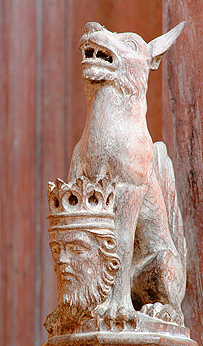
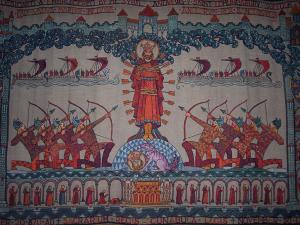
700~1000AD - Útlagi
placed this stone in memory of Sveinn -Rune sm103 - Småland
990~1010AD - Utlage
raised this stone in memory of Eyvindr, a very good thegn -
Ballstorp, Edsvära, Västergötland, Sweden (dated by style - maybe
earlier)
Very exciting - Geat's - Wuffing - Utlage evidence: Rune stone, Ballstorp, Edsvära, Västergötland, Sweden
English: Men at a rune stone (Vg 62) in Ballstorp, Edsvära.
The inscription says:
"Utlage
raised this stone in memory of Eyvindr, a very good thegn".
A "thegn" might be a peasant proprietor, yeoman or a warrior.
Parish (socken): Edsvära
Province (landskap): Västergötland
County (län): Västra Götaland
Rune stone, Ballstorp, Edsvära, Västergötland, Sweden
Flickr Swedish National Heritage Board's Photostream
| - - - -
Runic Dictionary inscription Vg 62
period/dating: V - V, meaning Viking
Age, which is very broad spanning the late 8th to 11th centuries
style group: RAK -- ca. 990-1010 AD
english: Útlagi
raised this stone in memory of Eyvindr, a very good Thegn.
| - - - - -
Västergötland - There are many ancient remains in Västergötland. Most prominent are probably the dolmens from the Funnelbeaker culture, in the Falköping area south of lake Vänern. Finnestorp, near Larv, was a weapons sacrificial site from the Iron Age.[3]
The population of Västergötland, the Geats appear in the writings of the Greek Ptolemaios (as Goutai), and they appear as Gautigoths in Jordanes' work in the 6th century.
The province of Västergötland represents the heartland of Götaland, once an independent petty kingdom with a long line of Geatish kings. These are mainly described in foreign sources (Frankish) and through legends. It is possible that Västergötland had the same king as the rest of Sweden at the time of the monk Ansgar's mission to Sweden in the 9th century, but both the date and nature of its inclusion into the Swedish kingdom is a matter of much debate. Some date it as early as the 6th century, based on the Swedish-Geatish wars in Beowulf epos; others date it as late as the 12th century.
| - - - - - -
750~1000AD - Útlagi placed this stone in memory of Sveinn -Rune sm103 - Östergötland
Runic Dictionary inscription Sm 103 - Now this is in Wulfing territory:
Sweden:
Småland
Location: Rösa, Skede sn, Östra hd;
period/dating: V - V, meaning Viking
Age, which is very broad spanning the late 8th to 11th centuries
english: Útlagi placed this stone in memory of Sveinn - Småland
| - - - - -
The small lands of Småland. The black and red spots indicate runestones. The red spots indicate runestones telling of long voyages.
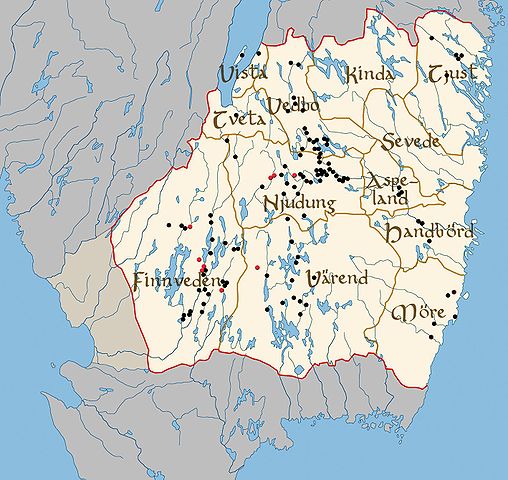 Småland
- is a historical province
(landskap) in southern Sweden.
Småland borders Blekinge,
Scania or Skåne,
Halland, Västergötland,
Östergötland
and the island Öland
in the Baltic
Sea. The name Småland literally means Small Lands.[2]
The latinized
form Smolandia
has been used in other languages. The highest summit in Småland is Tomtabacken
with its 377 m
Småland
- is a historical province
(landskap) in southern Sweden.
Småland borders Blekinge,
Scania or Skåne,
Halland, Västergötland,
Östergötland
and the island Öland
in the Baltic
Sea. The name Småland literally means Small Lands.[2]
The latinized
form Smolandia
has been used in other languages. The highest summit in Småland is Tomtabacken
with its 377 m
...
The name Småland ("small lands") comes from the fact that it
was a combination of several independent lands, Kinda (today a part of Östergötland),
Tveta, Vista, Vedbo, Tjust,
Sevede, Aspeland, Handbörd, Möre,
Värend, Finnveden
and Njudung. Every small land had its own law in the Viking age and early
middle age and could declare themselves neutral in wars Sweden was involved in,
at least if the King had no army present at the parliamentary debate. Around
1350, under the king Magnus
Eriksson a national law was introduced in Sweden, and the historic provinces
lost much of their old independence.
The city of Kalmar is one of the oldest cities of Sweden, and was in the medieval age the southernmost and the third largest city in Sweden, when it was a center for export of iron, which, in many cases, was handled by German merchants... IKEA was also founded in the Småland city of Älmhult
8_001_019 Sutton Hoo-The Evidence of the Documents By J. L. N. O'LOUGHLIN - Bjorkman, while in no doubt that the Wylfings were to be localized in southern Sweden, hazarded the conjecture that, if the Wylfings were not, in fact, Geats (Gotar}, their most probable home was in Blekinge. He then identified them with the Gothic Wulfings, the Heruli, who were known to have settled in southern Sweden, in Blekinge or in southern Smaland, on their return from southern Europe.
Götaland - Gothia, Gothland,[1][2] Gothenland, Gautland or Geatland is one of three lands of Sweden and comprises provinces.... Götaland once consisted of petty kingdoms, which its inhabitants called Gautar in Old Norse. It is generally agreed that these were the same as the Geatas, the people of the hero Beowulf (8th11th century) in England's national epic by the same name.
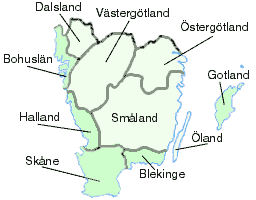 Blekinge
- is one of the traditional provinces
of Sweden (landskap), situated in the south of the country. It
borders Småland,
Scania and the Baltic
Sea. It is the country's second-smallest province by area (only Öland
is smaller), and the smallest province located on the mainland.
... Blekinge became part of the kingdom of Denmark
at some point in the early 1000s - most likely 1026.
Its status before then is unknown
Blekinge
- is one of the traditional provinces
of Sweden (landskap), situated in the south of the country. It
borders Småland,
Scania and the Baltic
Sea. It is the country's second-smallest province by area (only Öland
is smaller), and the smallest province located on the mainland.
... Blekinge became part of the kingdom of Denmark
at some point in the early 1000s - most likely 1026.
Its status before then is unknown
| - - - -
Östergötland - The traditions of Östergötland date back into the Viking age, the undocumented Iron Age, and earlier, when this region had its own laws and kings (see Geatish kings and Wulfings). It is said that the famous Viking warrior Beowulf may likely have been from what is now the Östergötland region. The region kept its own laws, the Östgötalagen, into the Middle Ages. Östergötland belonged to the Christian heartland of the late Iron Age and early medieval Sweden. The Sverker and Bjälbo dynasties played pivotal roles in the consolidation of Sweden.
The province has about 50,000 ancient remains of different kinds. Some 1,749 are, for instance, grave fields
| - - - - -
Rune Distribution: "Later" Vg62 is north-west of "earlier" sm103:
Runic Dictionary manuscripts search Utlag - Notice the close relationship to Denmark and Norway :
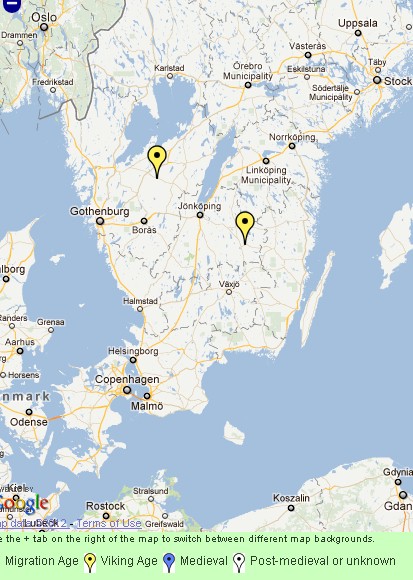
This is a map showing the locations of the Utlag Rune Stones Notice both are
concidered in the Viking Age
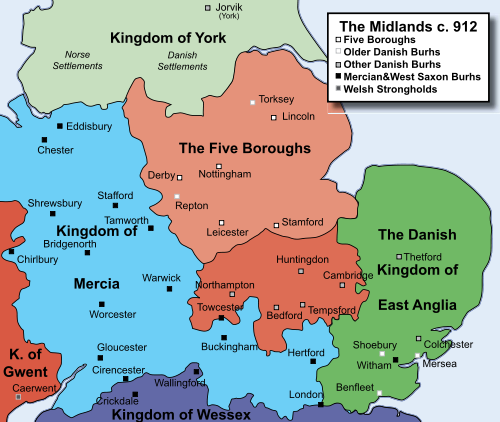
Hereward the Wake was Anglo-Danish - Outlawe
Hereward the Wake - (c. 1035 1072), known in his own times as Hereward the Outlaw or Hereward the Exile, was an 11th-century Anglo-Danish leader (cited by author Peter Rex- hence the rebel leader's ability to call upon Scandinavian aid in 1069) involved in resistance to the Norman conquest of England.
Hereward the Wake, England's national hero, wasn't really English after all - This Britain, UK - The Independent By David Keys Sunday, 20 February 2005
One of history's "greatest Englishmen" wasn't really English at
all. Hereward the Wake, the guerrilla leader who fought William the Conqueror
for five years from 1066, was, according to new research, was a
high-ranking Dane.
...
But an in-depth study, Hereward, the Last Englishman, to be published this
week, reveals that Hereward was the son of a prominent Anglo-Danish magnate
called Asketil.
The research by the historian Peter Rex sheds a
fascinating light on the political circumstances of the time. Ever since the
late ninth-century Viking raids, parts of eastern England had often come under
Danish control - and for some of the 11th century the whole of England became
part of a vast Danish empire, which also included Norway, southern Sweden.
...
England became the subject of a geopolitical tug-of-war between the
Scandinavians and the Normans.
The half-Norman English king Edward the Confessor was intensely pro-Norman, while his half-Danish successor Harold was supported by the Anglo-Danish community. ...
Interesting let's look at the history of the Danish invasion of England timeline .... When did the Utlag's come to England?
450AD - Kingdom of East Anglia - was settled by the Anglo-Saxons as early as around 450, earlier than many other regions. It emerged from the settlement and political consolidation of Angles in the approximate area of the former territory of the Iceni ... According to Bede, the East Angles (as well as the Middle Angles, the Mercians and the Northumbrians) were descended from natives of Angeln ... the first reference to the East Angles is from around 704713, in the Whitby Life of St Gregory ... The East Angles were initially ruled by the pagan Wuffingas dynasty, apparently named after an early king, Wuffa, although his name could have been an invention to explain the dynastic name, which means 'descendants of the wolf'
500-600AD - Wehha of East Anglia - Wehha was a pagan king of the East Angles who, if he actually existed, ruled the kingdom of East Anglia during the 6th century, at the time the kingdom was being established by migrants from the Jutland peninsula. Early sources identify him as a member of the Wuffingas dynasty, which became established around the east coast of Suffolk. Nothing of his reign is known. - Wehha is thought to have been one of the earliest rulers of East Anglia, an independent and long-lived Anglo-Saxon kingdom that was established in the 6th century, and which includes the modern English counties of Norfolk and Suffolk. ... Rainbird Clarke identified Wehha, the founder of the dynasty, as one of the leaders of the new arrivals: the East Angles are tentatively identified with the Geats of the Old English poem Beowulf.
600-749AD - Wuffa of East Anglia - By tradition Wuffa was named as the son of Wehha and the father of Tytila, but it is not known with any certainty that Wuffa was an actual historical figure. The name Wuffa was the eponym for the Wuffingas dynasty, the ruling royal family of the East Angles until 749. ... It has been suggested that Wuffa and his dynasty may possibly have originated from a Germanic tribe known as the Warni: Wuffa has been identified with the 'King of the Angli', as depicted by the Byzantine scholar Procopius.
616AD - Tytila of East Anglia - (died around 616) was a semi-historical pagan king of East Anglia, a small Anglo-Saxon kingdom which today includes the English counties of Norfolk and Suffolk. ... Tytila was succeeded by his son Rædwald in about 616.
700~1000AD - Útlagi
placed this stone in memory of Sveinn -Rune sm103 - Småland,
Sweden
866AD - Jorvik
and the Danes 866AD-900AD - A Danish army of around 10,000 men invades East
Anglia where it encamps for the whole winter. The Danes are led by Ivar the
Boneless (so called because of his lanky, gangling appearance) along with his
brothers, Halfdene and Hubba.
Here we can show that the early Utlag's may have originally been from East Anglia and may have been of the Wuffings (Geatish/Swedish origins) or Viking Danish.... By the time of King Edwy and King Edgar the Utlag's may have been politically connected to the land of East Anglia which was now an earldom . ...
869 - Wuffing King Edmund is martyred by the Danes near Thetford - Last of the Wuffing Kings
878AD - Danelaw - ALFRED DEFEATS THE DANES (England) Alfred the Great of Wessex defeats a Danish army under the leadership of Guthred.
879AD - Kingdom
of East Anglia - the Vikings
defeated the East Anglians in battle and their king, Edmund
of East Anglia, was killed. After 879, the Vikings settled permanently in
East Anglia
The Danelaw
roughly comprises 15 shires: Yorkshire,
Five
Boroughs of Leicester,
Nottingham,
Derby, Stamford
and Lincoln,
as well as Essex,
the Kingdom
of East Anglia shires of Cambridgeshire,
Suffolk and Norfolk,
East
Midlands shires of Northamptonshire,
Huntingdonshire,
Bedfordshire,
Hertfordshire,
Middlesex
and Buckinghamshire;
one third of the total area of the English kingdom at the time ... This peace
lasted until 884, when Guthrum again attacked Wessex. Alfred defeated him, with
peace codified in the Treaty of Alfred and Guthrum
910AD - Danelaw - Edward the Elder and his sister, Æthelflæd, the Lady of the Mercians, conquered Danish territories in the Midlands and East Anglia in a series of campaigns in the 910s, and some Danish jarls who submitted were allowed to keep their lands

920 - Edward the Elder
takes East Anglia from the Danes
957 - Outlawe(s) Banished
for political offences to Ireland by King Edwy - St. Dunstan Banished -
1613
Visitation Legend
959-960 - Outlawe(s) Return to England "with many wolves
heads" - King
Edgar reigns - St. Dunstan returns
960 - King
Edgar general pardon in return for a certain number of wolves' tongues
from each criminal
968-1016AD - Ethelred
II (king of England) - (born 968?died April 23, 1016, London,
England), king of the English from 978 to 1013 and from 1014 to 1016. He
was an ineffectual ruler who failed to prevent the Danes from overrunning
England. ... Danish invasions resumed in 980.
Nearly all of the country was ravaged, and Ethelreds efforts to buy peace only made the invaders more rapacious. When they did begin to settle down in towns, Ethelred provoked further invasions by launching a massacre of Danish settlers (Nov. 13, 1002). By the end of 1013 the Danish king Sweyn I had been accepted as king in England, and Ethelred had fled to Normandy.
990~1010AD - Utlage raised this stone in memory of Öjvind, a very good thegn - Rune vg62 - Ballstorp, Västergötland, Sweden
991AD - Danegeld - English payment, of 10,000 Roman pounds (3,300 kg) of silver, was first made in 991 following the Viking victory at the Battle of Maldon in Essex, when King Aethelred "The Unready" was advised by Archbishop Sigeric of Canterbury and the aldermen of the south-western provinces to buy off the Vikings rather than continue the armed struggle.
994AD - Danegeld - Danes, under King Sweyn Forkbeard and Olav Tryggvason, returned and laid siege to London. They were once more bought off, and the amount of silver paid impressed the Danes with the idea that it was more profitable to extort payments from the English than to take whatever booty they could plunder.
1002 - Danegeld
1002 - St.
Brice's Day massacre - was the killing of Danes
in the Kingdom
of England on 13 November 1002, ordered by King Æthelred
the Unready. In 1002 the king was told that the Danish men in England
"would faithlessly take his life, and then all his councillors, and possess
his kingdom afterwards." In response, he "ordered slain all the Danish
men who were in England."
1007 - Danegeld - Aethelred bought two years peace with the Danes for 36,000 troy pounds (13,400 kg) of silver
1012 - Danegeld - 1012, following the capture and murder of the Archbishop of Canterbury, and the sack of Canterbury, the Danes were bought off with another 48,000 troy pounds (17,900 kg) of silver.
1012 - Thorkell and his loyalists defected and he and his men entered into the service of king Ethelred the Unready, whom they fought under in 1013 against the invasion of king Sweyn Forkbeard and his son Cnut
1014 - Danish Earl Thurctel -(Thurkill) - sides with the Cnut - Scandinavian loan-words in Middle - Thurcytel Thorgils Havi , Earl - Earl married Eadgyth (?), daughter of Æthelred II 'the Unready', King of England and Ælgifu (?).1 He died in 1039.1
1016-1035 - Danelaw
-- From 1016 to 1035 Cnut
the Great ruled over a unified English kingdom
1016 - Danegeld - Sweyn
Forkbeard's son, Canute,
became King of England. After two years he felt sufficiently in control of
his new kingdom to the extent of being able to pay off all but 40 ships of his
invasion fleet, which were retained as a personal bodyguard, with a huge
Danegeld of 72,000 troy pounds (26,900 kg) of silver collected nationally,
plus a further 10,500 pounds (3,900 kg) of silver collected from London.
1017 - Thorkell the
Tall - he was proclaimed to be the Jarl
of East
Anglia, in 1017, after the coronation of the Viking king of England.
| -- - - - - -
Here is theory that the Danes lived in Norfolk/East Anglia before the time of the Romans!!! :
A
history of Norfolk - Norfolk before the Normans - THE EARLIER DANES
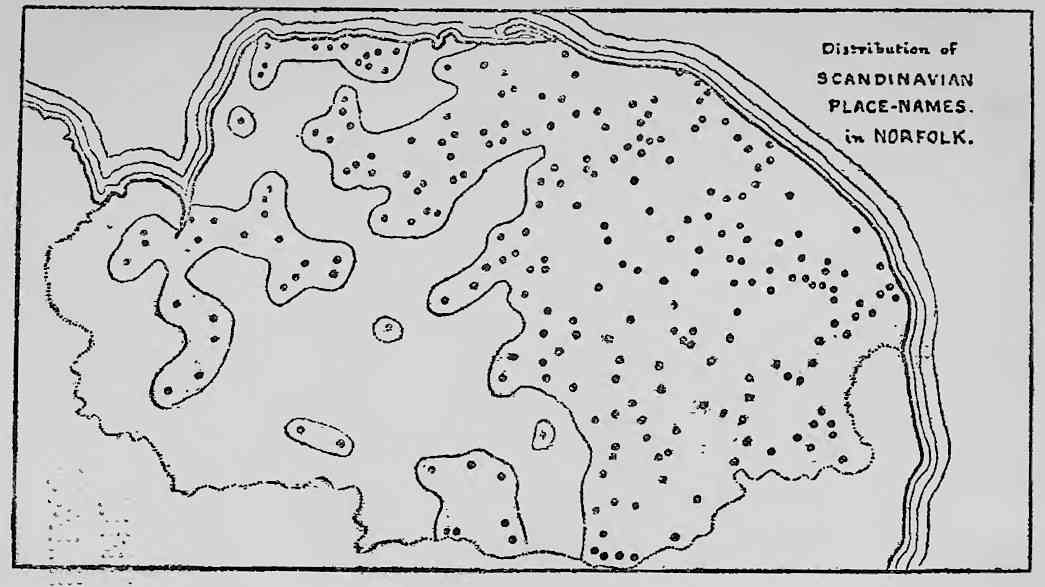
The people of whose existence we have the first tangible and undoubted proof in
our county are, to my mind, the Danes, whose first, and I think hitherto
unsuspected, invasion, I hope to show was before that of the Romans, and
not after those of the Romans and Saxons.
As I shall prove hereafter, there are chiefly in the N.E, half of the
county 256 places, either identical wholly (78) or in part (53) in name
with villages still in Denmark, or provable to be Danish by their prefixes or affixes
(125). How many more in the same district were also colonized by the Danes,
it is now impossible to say ; but it is clear that the colonization
whenever it took place was in that part of the county almost an
exclusive one. That it was anterior to the Romans seems to me clear, for we find
the root syllables of Brancaster and Tasburgh represented to this day in
Denmark ; and it is absurd to suppose that this enormous and comprehensive
invasion was the result of the intermittent rushes of the pirate Danes of the
ninth and tenth centuries. As my proposed transference of epochs is sure to
meet with determined opposition, I must be excused if I go into the question of
Danish settlements in Norfolk at considerable length.
...
Again, the acceptance of the theory of ' transplantation ' of place-names frees
us from the absurdity of many of our so-called derivations. We need no longer
believe that Scarning was a 'dirty village,' or Dereham so called from its deer,
that Burnham Deepdale was so called from a non-existent dale, that Felbrigg
was a bridge where there was no water, or that Pulham was a village of wells, or
that Ling-wood meant a wood of ling.
...
Grant that place-names were transplanted in ages ago as they are now-a-days, we
may easily understand that the original Danish village may well have been in
a dale, while the Norfolk one that took its name from it is on a hill.
Besides these absolute identities, we find there are fifty-three names of
places the first and characteristic parts of which are identical with those of
Danish villages, viz.
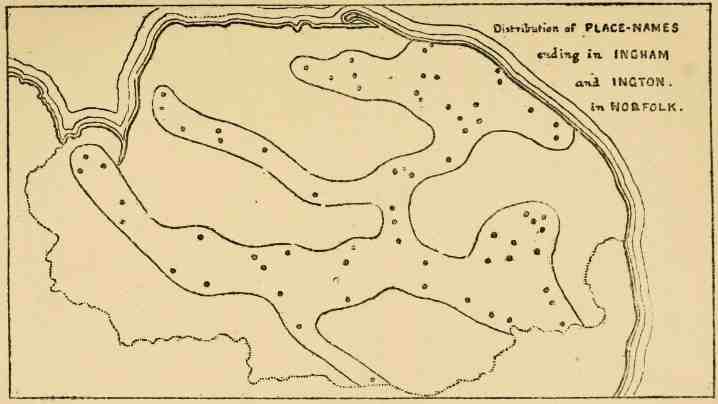 (Hindringham)
(Hindringham)
Anglo Saxon England
- East Anglian kings were called Wuffings, after King Wuffa; the Kentish
dynasty of Oiscings were descended from Oisc.
The Southern Saxons' kingdom
became Sussex and the Western Saxons' Wessex.
Wolf Song of Alaska
The Disappearance of Wolves in the British Isles - Probably one of the earliest references is contained in a manuscript at the
British Museum. A genealogy of Anglo-Saxon dynasties records the East Anglian
founder of a dynasty called "Wuffa" and his tribe, who were known
as "Wuffings" (Wolf people).
These genealogies were written in
A.D. 800 and Wuffa is thought to have ruled about 575 A.D.
Wuffa of East Anglia
- (died c. 578) was king of East Anglia from 571 to 578. He was the
father of King Tytila and grandfather of King Rædwald of the Sutton Hoo ship
burial.
His name, which is a diminutive form of the Old English word for wolf, is
the dynastic eponym for the kings of East Anglia, the Wuffings.
Sam Newton - About Other
Wuffing and Related Sites
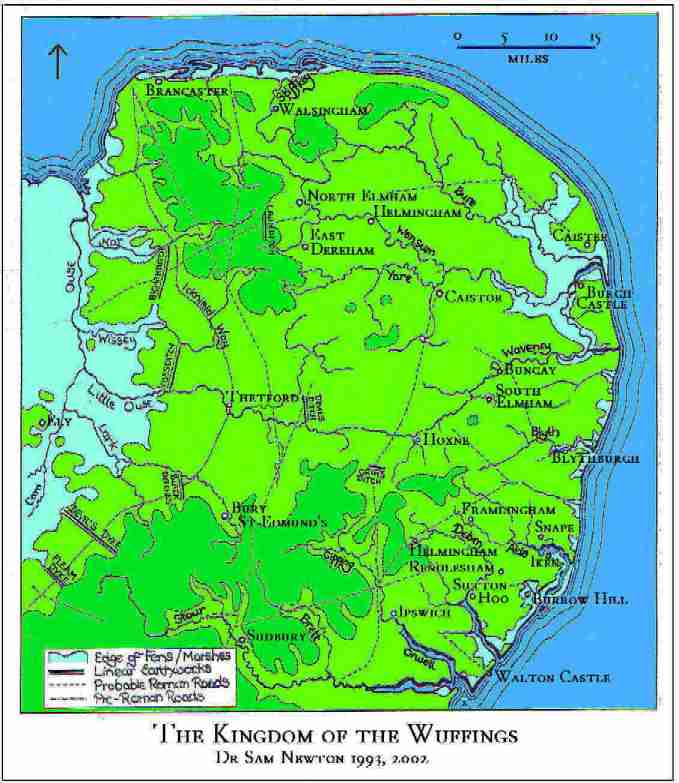 Wuffing -
List of the Later East Anglian Kings
Wuffing -
List of the Later East Anglian Kings
EADMUND (ST EDMUND) (c.853-20th Nov., 869); killed by the Danes,
possibly in battle near Thetford, as the Anglo-Saxon Chronicle seems to say;
eventually buried at Beodericsworð (Bury St Edmund's); the cult of St Edmund
became one of the most powerful in Medieval England.
The Royal Money Belt
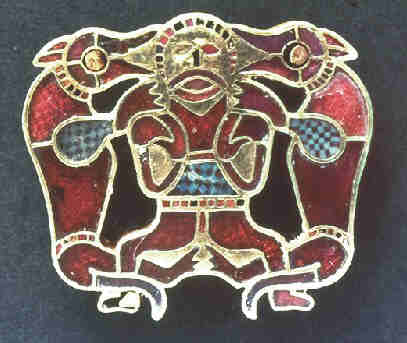 This
mount has been formed from
90 garnet and millefiori glass gems set in gold and enhanced by 13 gold
'lidded" cells. The animals flanking the central figure have been
identified as wolves and it is tempting to hold the view that this configuration
of forms was intended to realise the totemic relationship of the wolf to the
Wuffing kings.
This
mount has been formed from
90 garnet and millefiori glass gems set in gold and enhanced by 13 gold
'lidded" cells. The animals flanking the central figure have been
identified as wolves and it is tempting to hold the view that this configuration
of forms was intended to realise the totemic relationship of the wolf to the
Wuffing kings.
That they regarded the wolf as one of their special family emblems or totem is implicit in the name 'Wuffings', the kin of Wuffa, 'Little Wolf'.
The Old English Wuffingas is also a variant of Wulfingas, meaning 'the kin (children / descendants) of the wolf', a ancient type of folk-name denoting an ultimately totemic affinity with the wolf.
The most well-known story of the wolf with an East Anglian king is that of one of the last of the Wuffings, St Edmund. According to the earliest version of the legend of his martydom, his severed head was protected from the creatures of the wildwood by a miraculous wolf.
As
well as an association with origins, a totemic animal would also have
functioned as a source of knowledge and protective to the family. As
such, perhaps the peculiar flanking position of the wolves here may be regarded
as representing the ancestral guardian spirit of the Wuffings.
For
further discussion of this key point and the relation of the Wuffings to the
Wulfings of Old English heroic poetry, see Sam
Newton's book, The
Origins of Beowulf and the pre-Viking Kingdom of East Anglia,
pp.106-109, and the references there cited.
Traditional English and Anglo-Saxon Tattoos
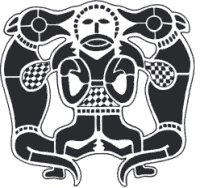 TIW
-
This image shows the Anglo-Saxon god Tiw with a wolf like creature on either
side [Geri and Freki no?].
TIW
-
This image shows the Anglo-Saxon god Tiw with a wolf like creature on either
side [Geri and Freki no?].
This image of Tiw was found on ornately crafted jewelry from the Sutton Hoo burial. He is possibly the oldest of all the gods worshipped by the early English. From the god Tiw we get the day Tuesday as well as many place names scattered across England. He was the god of war and was worshipped and evoked during times of battle.
Tiw lost his right hand through an act of bravery and thus his symbol was said to evoke honour and courage.
He was the protector of all warriors, but was also said to watch over the disabled, and the left-handed. His runic symbol was stamped onto swords and other weapons to give them strength and to guide their users hand.
The Anglo-Saxon rune poem explains the meaning of the rune tir using the
imagery of a star that had the same name (probably the North Star):
Tiw is a guiding star; well does it keep faith with princes;
it is ever on its course over the mists of night and never fails.
Geri and Freki - In Norse mythology, Geri and Freki (Old Norse, both meaning "the ravenous" or "greedy one") are two wolves which are said to accompany the god Odin. - Historian Michael Spiedel connects Geri and Freki with archaeological finds depicting figures wearing wolf-pelts and frequently found wolf-related names among the Germanic peoples, including Wulfhroc ("Wolf-Frock"), Wolfhetan ("Wolf-Hide"), Isangrim ("Grey-Mask"), Scrutolf ("Garb-Wolf") and Wolfgang ("Wolf-Gait"), Wolfdregil ("Wolf-Runner"), and Vulfolaic ("Wolf-Dancer") and myths regarding wolf warriors from Norse mythology (such as the Úlfhéðnar). Spiegel believes this points to the pan-Germanic wolf-warrior band cult centered around Odin that waned away after Christianization.[18] - Elaborating on the connection between wolves and figures of great power, he writes: "This is why Geri and Freki, the wolves at Woden's side, also glowered on the throne of the Anglo-Saxon kings. Wolf-warriors, like Geri and Freki, were not mere animals but mythical beings: as Woden's followers they bodied forth his might, and so did wolf-warriors."[18]
Anglo Saxon - Symbols & Customs
Wolf - An animal not solely associated with negative aspects (Fenris, Garm etc.), but also
a respected animal among the Anglo-Saxons.
It symbolised loyalty, power and freedom, the wolf could be found engraved on various war gear as well as being carved in stone and other mediums. Names used among the 'Germanic' peoples reflect this veneration, 'wulf', 'wuffa' or
'wuffingas'.
The White Wolf, along with the White Draca & White Horse, is an emblem of the ethnic English.
Troth - Synonyms: oath, pledge, promise, vow, word
Law god ---whole abide.
thing god---strong king,
You fed the wolf--when others would not,
you took his troth---when tied was he,
your hand took the wolf---when you bound the outlaw,
so one handed god---they call you.
Tiw you are a symbol---you hold troth well,
with the princes---when you travel,
over night's mists---never do you mislead.
Victory symbol to many---loyal leader on paths,
those whom right hold dear---Your hand call on,
for truth---for law, and for what's dear,
for great deeds---and mighty words.
The people praise your Temple---and praise your name,
Victory lord---Truth father,
One handed god---law god; [ Tiw is "left-handed"
since his right hand has been taken by Fenrir the wolf ]
Deem good our deeds---and our warriors.
Aries
and The Tarot - The associated Rune is Tiwaz...Rune of the
Warrior. It is representative of Tiw (also referred to as Tyr), Norse God of battle, justice, law, regulation and success through sacrifice. This is also the God after whom Tuesday is named and, in some cultures, was considered to be the Protector of Mariners as well as the Protector of Warriors in both a physical and spiritual sense.
He also patron of the disabled and those individuals who are left-handed. Tiw allowed Fenrir the Wolf to bite off his right hand in order to protect his warriors from the forces of chaos.
Tiw was courageous and fearless, as well as being an accomplished diplomat. These qualities are symbolized by Tiwaz...a Rune which also
reinforces determination and male sexuality. It is symbolic of new challenges and initiations into new understandings. This Rune suggests that if there should be a need for courage, then victory is already assured if the heart remains true. However, it will be necessary to make use of all the personal skill and wisdom acquired thus far. Faith must also be protected as it will invariably be challenged. Nonetheless,
truth, honesty and justice will always prevail in the end. The Runic Number of Tiwaz is 17.
Its color is bright red, its element is air and its polarity is male.
WORLD OF WICCAN GODS?
Tîwaz - (aka Tyr (Scandinavia), Tiw (Saxon), Seaxneat, Saxnot (Saxons in Essex), Tig, Zio (Dutch), Ziu (German)) was the Teutonic war and "Sky God".
Great sacrifices were made to this God whom loved both law and justice.
As Tyr, he was the original Scandinavian God of war as well as the patron God of justice. Tyr represents the letter of the law. The Vikings demoted Tyr, making Odin the God of war. (Interestingly, Tyr was then regarded as Odin's son.)
He inspired courage and heroism, and was the giver of victories in battle.
Tyr's right hand was bitten off by Loki's son, the monstrous wolf Fenrir, when he bound the wolf. Tyr is always represented with one hand.
Tiw, the Saxon form of Tîwaz, was the original "great God", whom separated heaven and earth.
In "Lokasenna", Loki boasts of cuckolding Tiw, without restitution. The name of Tiw's wife is not recorded.
Tîwaz's magical items are a shield, helmet and sword. He is invoked for battle glory, justice, oaths and arbitration.
TIW - justice, oaths and arbitration. - The Wuffings - St. Edmund - Magna Carta
Bury St Edmunds
Abbey - It is the main town in the borough of St Edmundsbury
and known for the ruined abbey near the town centre.
...
Bury St Edmunds (Beodericsworth, St Edmund's Bury), supposed by
some to have been the Villa Faustina of the Romans, was one of the
royal towns of the Saxons.[2] Sigebert, king of the East Angles, founded a
monastery here about 633, which in 903 became the burial place of King Edmund,
who was slain by the Danes in 869, and owed most of its early celebrity to the reputed
miracles performed at the shrine of the martyr king
...
The town is associated with Magna Carta. In 1214 the barons of England are
believed to have met in the Abbey Church and sworn to force King John to accept
the Charter of Liberties, the document which influenced the creation of the
Magna Carta.
Bury St Edmunds Abbey - Inscription, abbey ruins, enforcement of the Magna Carta, signed in 1215
THE LIGHT FROM THE EAST: ENGLAND'S FORGOTTEN PATRON-SAINT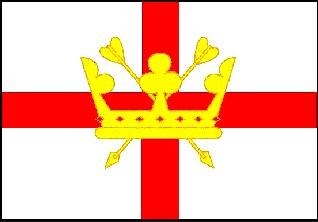 'I
have vowed to live under Christ, to live under Christ alone, to reign under Christ alone'.
'I
have vowed to live under Christ, to live under Christ alone, to reign under Christ alone'.
Although St Edmund has been the patron-saint of England for well over a thousand years, he has gradually been sidelined and today, in this land without saints, he is almost forgotten. Indeed, ever since the definitive establishment of the Normans in this country in the twelfth century, he has come to be neglected. Just as the Normans attempted to replace popular veneration for the Righteous English King Alfred with their fairy-tales and myths of the Non-English King Arthur, so they also tried to replace the memory of the English St Edmund with their crusaders' version of St George.
Edmund (Eadmund) was born on Christmas Day 841. Christian from infancy, in
856 he succeeded to the throne of what was perhaps the cradle of the English
Nation in East Anglia. During his brief reign he came to fight alongside the
future King Alfred in order to defend England from the invasions of the pagan
Vikings. In 869 a great Viking army landed on the shores of his kingdom and
Edmund marched out at the head of his army to defend the realm.
The King was defeated and captured. In captivity he was ordered to renounce
his faith and become a vassal of the heathen Danes, orders which he stoutly
rejected. Repeating the name of Christ with his heart and his lips, he told
them: 'Living or dead, nothing shall separate me from the love of Christ'.
He was tied to a tree, tortured by being shot through with arrows, and then
beheaded. His martyrdom took place on 20 November 869 at Hoxne in High Suffolk
and his body was buried in a small wooden chapel nearby.
In 902 the relics, still incorrupt, were translated to Bedricsworth, at the
very crossways of the four counties of Eastern England - Norfolk, Suffolk, Essex
and Cambridgeshire.
This town soon came to be called 'Edmundstowe', 'Edmundston' and finally was
renamed Bury St. Edmunds. From this time on St Edmund became a local, and
soon, national patron. In 929 the humble pilgrim King Athelstan founded a
community to care for his shrine. In 945 another royal grandson of King Alfred,
called Edmund, gave them further lands. St. Edmund had become the ideal English
hero, a king and a martyr. The last purely English King of England, Edmund
Ironside (+1014), was also named after him.
In 1020 a monastic church was built over his shrine by King Canute and this was served by monks from Ely. Even after the final Viking Invasion and Occupation of 1066, the martyr's relics were placed in a refurbished shrine in a new church in 1095 and they continued to be a place of national pilgrimage.
However, in 1199 the French King of England, Richard I, was to call at the tomb of St. George in Lydda, while on the Third Crusade. Invoking the saint, he won a great victory and consequently placed himself and his army under St. George's protection.
St. Edmund, however, remained the national patron. Thus in 1214 the future Magna Carta barons, in opposing Richard's younger brother, King John, rode to Bury St. Edmunds on St Edmund's day to make a pledge at the altar of St. Edmund to strengthen the national cause. In 1215 the Magna Carta was signed by King John in the water meadows of Runnymede. As a result of this historic event the motto of Bury St Edmunds remains to this day: 'Shrine of a King, Cradle of the Law'.
However, in the dynastic struggle after the hated King John's death in 1216, nearly all St Edmund's relics were stolen by French knights in 1217. They were taken to Toulouse in France and here they remained until 1901. The first consequence of this loss was that three years later, in 1220, St. George, already the personal patron of the sovereign, was inserted in the national calendar by Richard I's nephew, Henry III (1216-1272). Although the banner of St. Edmund was still carried by English forces in battle, by the time of Edward I (1272-1307) it had been joined by the banner of St. George.
The eclipse of St. Edmund continued in the reign of Edward III (1327-77) with the founding of the Order of the Garter dedicated to Our Lady and St. George. The English veneration of kingship allowed St. George to usurp the national patronage, although his title was never patron but 'specyel protectour and defendour of this royaume' (special protector and defender of the realm). However, even as late as the reign of Richard 11 (1377-99), a fine representation of St. Edmund as a national patron was made in the Wilton Diptych. In this he was accompanied by Edward the Confessor and St. John the Baptist as personal patrons, and there was still no sign of St. George.
Although in the reign of Henry VII (1457-1509), St. George was still only designated 'protector of the realm', it was under the Machiavellian tyrant Henry VIII (1491-1547) that St. Edmund became totally eclipsed. Henry actually removed St Edmund's name from the litanies of saints venerated in England and in 1539 he had the monastery at St Edmundsbury dissolved. Indeed after the Protestant Reformation, St George came to be one of the few saints to be at all known to the Protestant Church in England. Most of the relics of St Edmund (not the head-relic) were returned to the Roman Catholic authorities in England in 1901 and they are kept locked away at a private Catholic chapel in Arundel in Sussex.
Exult, O Holy Church of the English; behold to Thee it is given to praise the illustrious king and most invincible martyr Edmund, who triumphing over the kings of this world, went up to heaven with great victory. O Holy Father Edmund, hearken unto those who pray unto thee.
HOLY MARTYR EDMUND, PRAY TO GOD FOR US!
The History of the legend of Saint Edmund
Sacrarium Regis Shrine of a King
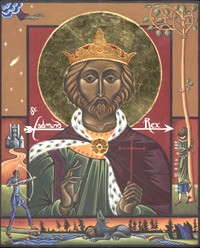 The history of the legend of
Saint Edmund
The history of the legend of
Saint Edmund
One hundred and fifty years before the Norman Conquest the remains of St Edmund were moved from their first resting place close to the site of the martyrdom to Baedericesworth on the River Lark.
Less than 50 years after the removal of the remains to the new location the later King Edmund made a major grant of land in 945 to the monastery, securing the whole area of the later town within the boundary known as The Banleuca. Bury St Edmunds, as it later became known, was on the way to becoming one of the most wealthy and influential Abbeys in England.
But what of the Saint from whom it has taken its name? Edmund, King of the East Angles, is known only from two near contemporary sources: the Anglo Saxon Chronicle written by a monk between 877 - 899 and the remarkable memorial coinage, issued in around 890 and which continued for some 20 years. Beyond this date the well known details of the martyrdom of King Edmund, and the miracles attributed to him, come from sources increasingly distant from the date of his death, making it difficult to disentangle fact from enthusiasm.
The 'Kingdom' of East Anglia had its origins in the 5th century migrations of Angles and Saxons from North Germany and Denmark. Their settlements and culture are uniquely illustrated by the excavations and reconstructions of the early Anglo-Saxon village at West Stow, some seven miles to the west of Bury St Edmunds.
By the early 7th century towns began to be established, particularly Ipswich, signalling the dramatic changes taking place with continental trade, political and regal development and the introduction ofChristianity. East Anglia, that is Suffolk, Norfolk and most of Cambridgeshire, was an established kingdom based on the Royal House of the Wuffings. Their most notable King, Redwald, was buried in astonishing splendour at Sutton Hoo in 625. After the death of Redwald, who had been recognised as the 'High King of England', the fortunes of the kingdom fluctuated, with increasing pressures from and eventual domination of the Midland Kingdom of Mercia by 793 and Northumbriaby 821.
By the 9th century the East Anglian kings were eclipsed by their more powerful neighbours to a point where most are hardly known. The bald statement about Edmund's death in the Anglo Saxon Chronicle for the year 869 may have passed unnoticed if it were not for the remarkable reputation for miracles which rapidly accrued to his remains.
The development of the story of St Edmund is laid out below. It shows not only the year of the event (AD) but also how long each event was in distance of years from the time of the death of King Edmund.
| History of St Edmund | ||
|---|---|---|
| Years from Edmund's death |
AD | Event |
| - c.239 years | c.630 | King Sigeberht founds a monastery at Bedericesworth. So far, the archaeological evidence suggests this to have been a small settlement, much smaller than the area enclosed by the later monastery. |
| - 14 years | 855/6 | Edmund crowned at Bures according to the Annals of St Neots, an early 11th century record. |
| - 4 years | 865/866 | The Anglo Saxon Chronicle, a document begun by monks in Wessex within twenty years of Edmunds' death says,
"And this same year came a great host to England and took winter quarters in East Anglia, and there were provided with horses, and they made peace with them." |
| Death of Edmund | 869 | Anglo Saxon Chronicle: (Version A, written between 877 - 899)
"In this year the (Danish) host rode across Mercia into East Anglia and took winter quarters in Thetford and the same year King Edmund fought against them and the Danes had the victory, and they slew the King and overran the entire kingdom." Version 'B', copied at Peterborough 1103, adds "and destroyed all the monasteries to which they came." |
| The Danelaw: | - | The Danish invasions were followed by settlement and control over a large area of north and eastern England extending from the north-west (Lancashire) to London. This roughly coincided with the line of Watling Street and lasted for about 100 years, following the start of the reconquest of the Danelaw in 899 by Edward the Elder, following the successes of Alfred in West Mercia and Wessex. |
| + 20 years | 890 | The St Edmunds memorial coinage, current in East Anglia during the Danish rule, is a unique indication of the extraordinary reputation of Edmund, already recognised as a Saint. |
| + 23 years | 893 | Asser's 'Life of King Alfred' suggests Edmund was killed in battle, but not clearly enough to deny a martyrdom after his defeat. |
| + 27 years | c.906 | Saint Edmund's remains moved to Bedericesworth, implying an earlier burial elsewhere. (See the year 985). |
| + 74 years | 945 | King Edmund (not our Saint) grants a large area of land to the monastery - known as the Banleuca. This is a significant indication of the status of the shrine and the growing importance of the monastery. |
| + 116 years | 985 | Abbo
of Fleury, who wrote his "Life of
St Edmund" at Ramsey Abbey (near St
Ives, Cambridgeshire), adds most of the
details of the story. Although written
over a hundred years after the event,
his sources are clearly stated, and,
although unusual, must be regarded with
respect.
In a letter to Archbishop Dunstan, Abbo says he heard the Archbishop relate the story and that he said he heard it as a young man from a very old man who claimed to have been King Edmund's armour bearer at the time of his death. It is likely therefore, that the basics of the story are correct. The account recorded by Abbo is this: Two Danish leaders, Hinguar and Habba, came to Northumbria, which they overran. Hinguar proceeded to the east with a fleet and surprised a city which they sacked ... Eventually Edmund was taken prisoner, whipped and tied to a tree and shot with arrows 'until he bristled with them like a hedgehog or thistle'. He was then beheaded and the head thrown into bramble thickets in Hegelisdun Wood. The date was given as November 20th which remains St Edmunds' Feast Day today. The survivors searched for the head and found it guarded by a wolf and calling 'here, here, here'. The king was buried in a small chapel built for the purpose where the body remained for many years before being moved to Bedericsworth. |
| + 118 years | 987 | A copy of the story made by Aelfric adds that the martyrdom took place when King Alfred was 21. |
| + 122 years | 991 | Following further Danish raids in the late 10th century, a regular series of payments (Danegeld), as a kind of tax, was levied to buy off the Danes, beginning in 991 with £10,000 of silver to Olaf. It continued after the establishment of Danish rule. |
| + 141 years | 1010 | East Anglia was attacked by the Danes and Ipswich sacked, and so between 1010 and 1014 the Saint's body was taken to London for safety, and then returned. |
| + 145 years | 1014 | Sweyn Forkbeard (Cnut's father) was dramatically struck dead while threatening the sack of the town of St Edmunds or the payment of a heavy ransom. |
| + 147 years | 1016 | In 1016 Cnut (Canute) became King of all England and in 1017 raised a "Danegeld" of £82,500 which included £10,500 from London. The portions for other regions are not known. |
| + 151 years | 1020 | King Cnut established Benedictine monks at Bury. |
| + 163 years | 1032 | A new round church of stone was consecrated at Bury, situated to the north of the chancel of the later Norman Abbey Church. |
| + 173 years | 1042 | Danish rule ended in 1042 when the English king Edward the Confessor succeeded to the throne. |
| + 196 years | 1065 | Abbot Baldwin was appointed and begins a new church and by 1097 St Edmund was moved into the completed east end. |
| + 226 years | 1095 | Herman of Bury: in his book on the "Miracles of St Edmund" he located the site of the first burial at a place called Sutton close to the site of the martyrdom (his original version was in 1071). |
| + 232 years | 1101 | The claim of Hoxne to be the site of martyrdom was first noted in the foundation charter of Norwich Priory. |
| + 281 years | 1148-56 | Geoffrey of Wells added details of St Edmund's parentage and early life. |
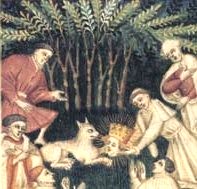 There are many accounts of
miracles associated with the Saint and of the
incorrupt nature of the body until at least 1198
when it was examined after a disastrous fire.
There are many accounts of
miracles associated with the Saint and of the
incorrupt nature of the body until at least 1198
when it was examined after a disastrous fire.
Even if the later and more colourful details are stripped away as accumulations around the core there remain three key sources which relate to the story:
'Hellesdon' (near Norwich) can be derived from 'Haegelisdun' has also been suggested but has no other supporting evidence. 'Sutton' has been equated with Sutton Hoo but there is no other evidence than the name.
In Bradfield St Clare some six miles south of Bury there is an old field name, 'Hellesdon'. This is not too much to go on, but there are other suggestive associations. To the north, there is a group of 'Kingshall' place names, and to the South a 'Sutton' Hall. This grouping of place names, so close to Bury itself, and not far from the winter head quarters of the Danish army at Thetford, is surely worthy of serious consideration.
The influence of St Edmund, the martyred king of East Anglia, survived the times of Danish domination and the Norman Conquest to become the focal point for the development of one of the greatest abbeys of England, whose abbey church was the largest in Europe, larger even than Norwich, built about the same time.
The reconstructions and interpretation of the Anglo-Saxon village at West Stow examine the very foundations on which the culture, wealth and influence of later Saxon England were built and find echoes in the ruins of the once great abbey of St Edmund.
Stoke Dry - is a village in the county of Rutland in the East Midlands of England, about three miles (5 km) southwest of Uppingham.
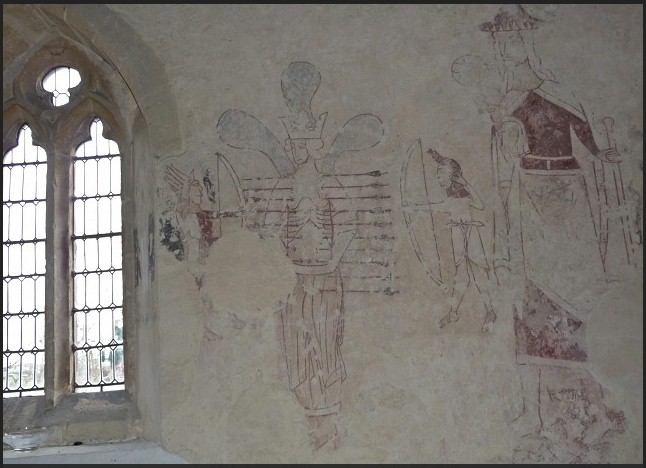 Blipfoto 27 March 2010
- Blipfoto About My Photographic footprint
Blipfoto 27 March 2010
- Blipfoto About My Photographic footprint
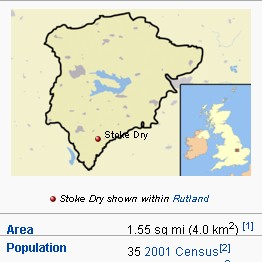 Stoke Dry
Stoke Dry
They say that some Gunpowder Plotting was done in the tiny room above the porch by Sir Everard Digby (who was hung for treason in 1606) , also that witches were left up there to starve to death. There is no evidence of this, and the plotting is in doubt.
But there are some very old murals still in evidence on the walls. Cromwell's troops of puritans didn't manage to scrub all these out.
The strangest of them are of a King or Saint being killed (with a gentle little twist of his lips) by figures with bows and arrows, dressed a bit like native Americans. These were
drawn centuries before Columbus, we have no idea where the artist got the idea.*
Stoke Dry History - Village History
The name 'Stoke Dry' has given rise to some speculation. The word Stoke is probably from the Saxon stokken which means a farm or land holding. Norse and Saxon usage put the adjective after the noun so whilst in Doomsday the village is referred to as Drystoke by 1300 we find reference to 'Thomas Nevill held Stoke Dry and half of Lyddington'. After the Nevills, Roger de Morewood's family held the village until it passed to the Digby family. The Digbys won fame through several notable scholars and Court officials to the Everard Digby who was hung drawn and quartered for his complicity in the gunpowder plot. Of Stoke Dry, Camden says It is never to be forgotten as being the ancient residence of the famous and ancient family of the Digbys; but branded with everlasting infamy by Everard Digby, who wickedly conspired, with other execrable incendiaries, to destroy his king and country at one blow of hellish thunder'. However there is no firm evidence that the small room above the porch in the church was ever used by the plotters, although it is a popular tradition.
There was a big house which stood above the church where these great families lived. In the Will of Anne Digby dated 1600 some 29 rooms and their contents are listed. Nothing of that house remains but many cut stones are built into boundary walls that may indicate total demolition after a serious fire. The church itself dates from the late tenth century but has been enlarged and modified since. Of the existing houses, some trace their origins back to the 1700s but probably most were altered, enlarged and the modern cottages built in 1840-1880. This must have been a prosperous time in the area.
The church itself has monuments to the Digby family, memorials to the Peach family, and an area of yard devoted to the Bryan family.
Some very significant murals in the Digby Chapel have been dated to 1280- 1284 and show figures resembling Red Indians which supports the view that North America was known at least 200 years before it was 'discovered by Christopher Columbus. The building was developed in the late fourteenth century with the top part of the tower added in the mid eighteenth century. It is still open for services even though it has yet to install electric lights.
Thus it can be seen that the village has grown from a patronage holding, where the family provided the income and the inhabitants the food, to the modern state where the two farms, some small business and domestic residences make up the whole structure.
Medieval painting of the Martyrdom of St. Edmund, Stoke Dry, Leics.
The partly-visible figure at the extreme right is St.
Christopher, now on the site in his complete form. The rest of the
photograph shows the Martyrdom of St. Edmund. He is bound to a very
stylised tree and wears his crown but is semi-naked, dressed only in a tunic
that has been stripped from his shoulders, the top part thus dangling below his
waist. The anatomy of his ribcage is very carefully delineated and his crossed
feet seem to be bound.
The many arrows piercing him are precisely and symmetrically arranged - whether
they were drawn freehand or ruled with a straight-edge is impossible to say now.
Two archers are shooting at Edmund, the one on the left wearing a
conventional bi-coloured tunic, the one on the right in a rather strange garment
apparently wrapped around his waist and fastened with a knotted belt. But he
wears tight leggings-type hose too, the bottom edge of which shows at his
ankles. His arms are not bare - there is a line at his left wrist which is
presumably the sleeve-edge of a very tight tunic.
The most interesting thing about the archers is their (apparently) feathered
headgear, which has led to much speculation about their resemblance to Americans
Indians, at least as they were depicted in the art of the Old World after the
Voyages of Discovery in the 16th century. The obvious difficulty here is the
date.
It would, I suppose, be possible to construct a hypothesis as follows: early Norse explorers such as Erik the Red and his son Leif Eriksson encountered in Greenland or the far north of the American continent indigenous peoples who wore feather headdresses similar to those of the stereotypical Red Indian known to every Western movie-goer of the last fifty years. They brought stories and descriptions of the strange people back to Europe, whence they were disseminated even to distant inland locations like Stoke Dry. Because the strangely dressed people in the stories were obviously pagans, and possibly also because the tellers of the tales were the descendants of the pagan Northmen responsible for Edmunds death, feathered headgear, paganism, perhaps also folklore about what the Danish raiders who had penetrated inland as far as nearby Stamford had worn and looked like, became inextricably linked in the minds of local people. When the painter (who was probably also a local man) made the Martyrdom of St. Edmund at Stoke Dry, his ideas about how to depict pagan barbarian assassins came straight out of this set of notions.
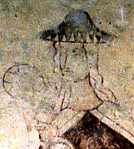 As with many unlikely hypotheses, there may be a grain of truth here, but the
objections are manifold¹. Strange hats and headgear were commonly used in
medieval painting of all kinds to signal paganism, barbarianism and generally
undesirable persons, foreign or otherwise. (Christ and his disciples went
bareheaded; Judas may
have worn a hat). But perhaps we need look no further than the lampshade-like
object worn on his head by St. Christopher (still technically a pagan when he
carried Christ across the river)
in the photograph at the left. The general shape of this hat is similar to
standard pilgrims headgear, but it is a strangely exotic version, and I have
never seen anything resembling it in an English St. Christopher painting before.
As with many unlikely hypotheses, there may be a grain of truth here, but the
objections are manifold¹. Strange hats and headgear were commonly used in
medieval painting of all kinds to signal paganism, barbarianism and generally
undesirable persons, foreign or otherwise. (Christ and his disciples went
bareheaded; Judas may
have worn a hat). But perhaps we need look no further than the lampshade-like
object worn on his head by St. Christopher (still technically a pagan when he
carried Christ across the river)
in the photograph at the left. The general shape of this hat is similar to
standard pilgrims headgear, but it is a strangely exotic version, and I have
never seen anything resembling it in an English St. Christopher painting before.
1326 - Suffolk manor of Lakenheath - Matthew Outlawe was said to owe half of the cost of trees needed to build a house - Matthew Outlawe of Lakenheath - Lakenheath - is a village in Suffolk, England. It has around 8,200 residents,[1] and is situated in the Forest Heath district of Suffolk, close to the county boundaries of both Norfolk and Cambridgeshire, and at the meeting point of the The Fens and the Breckland natural environments.
Lakenheath is remarkable for its medieval church, built in the local flint construction style. The church contains medieval paintings and medieval carving on the pews. The wall paintings, depicting local saint St Edmund, angels, and birds amongst other subjects, are believed to date from the 13th Century
My
Design for St. Edmund's Flag
Today we are supposed to venerate the usurper St. George as our patron Saint and celebrate the fact of our Englishness. I care not for the former and I do the latter in my heart every day of the year. As for the Levantine Dragon Slayer, he was no doubt a worthy fellow, but St. Edmund is a truer and better role model.
St. George had no real connection with England as such until the time of the crusades. Though he was undoubtedly venerated here, he was better known as an object of such veneration in the area of the eastern Orthodox Church. Crusaders from England and from the thirteenth century onwards St. George was accorded ever greater importance until, in due course, he became recognized as the patron Saint of England. We share him with Georgia, Genoa, the Hellenic Armed Forces, Beirut, Malta, North Ossetia, Aragon and the Freemasons. He supplanted an altogether more appropriate character in that office. In 869 the King of East Anglia, Edmund, was martyred by an invading Danish army. Captured by the invaders, he was ordered to renounce his Christian faith and to become heathen Danes vassal. Almost certainly knowing what the consequences would be, he flatly rebuffed his enemies' demands. Repeating the name of Christ with his heart and his lips, he told them: 'Living or dead, nothing shall separate me from the love of Christ'. He was tied to a tree, tortured by being shot through with arrows, and then beheaded.
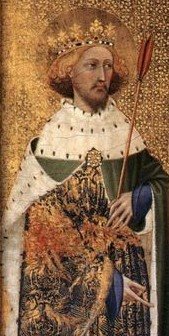 King Edmund, from the Wilton
Tryptych [ Notice the "Golden Hair" ]
Of him the Anglo-Saxon Chronicle says:
King Edmund, from the Wilton
Tryptych [ Notice the "Golden Hair" ]
Of him the Anglo-Saxon Chronicle says:
They talked together until Dunstan told him about saint Edmund, even as Edmund's sword-bearer had told the story to king Æthelstan when Dunstan was a young man and the sword-bearer a very old man. The monk put this whole story into a book, and a few years afterwards, when the book had come to us, we turned it into English just as it stands hereafter. Two years later this monk Abbo went home to his monastery and was almost immediately appointed abbot in that same monastery.
Edmund the blessed, king of the East Angles, was wise and honourable and by his excellent conduct ever glorified Almighty God. He was humble and devout, and continued so steadfast that he would not yield to shameful sins, nor in any direction did he bend aside his practices, but was always mindful of true doctrine.
If you are made a chief man, do not exalt yourself, but be among men as one of them. He was bountiful to the poor and like a father to widows, and with benignity guided his people ever to righteousness, and controlled the violent, and lived happily in the true faith. Then at length it happened that the Danish people came with a fleet, harrying and slaying widely over the land, as their custom is.
In that fleet were their chief men, Hingwar and Hubba, associated by the devil, and they landed in Northumbria with their ships and wasted the land and slew the people. Then Hingwar turned eastward with his ships, and Hubba was left in Northumbria, having won the victory by cruel means. Then Hingwar came rowing to East Anglia in the year when Alfred the ætheling was one and twenty years old, he who afterward became the renowned king of the West-Saxons.
And the aforesaid Hingwar suddenly, like a wolf, stalked over the land and slew the people--men, women and innocent children--and shamefully tormented innocent Christians. Then soon afterward he sent to the king a threatening message that he must bow down to do him homage, if he cared for his life. So the messenger came to King Edmund and speedily announced to him Hingwar's message: "Hingwar our king, keen and victorious by sea and by land, has rule over many peoples, and has now landed here suddenly with an army, intending to take up his winter-quarters here with his host. Now he commands you to divide your secret treasures and your ancestors' wealth quickly with him, and you shall be his under-king, if you desire to live, because you do not have the power to withstand him." King Edmund called a bishop, the one who was nearest to him at the time, and consulted with him how he should answer the savage Hingwar.
The bishop feared for this terrible misfortune and for the king's life, and said that it seemed best to him that he should submit to that which Hingwar had demanded of him. Then the king kept silence and looked at the ground, and at length said to him in kingly fashion: "Behold, oh bishop, the poor people of this land are brought to shame, and I would rather fall in battle so that my people can continued to possess their land." And the bishop said, "Alas, dear king, your people lie slain, and you do not have sufficient forces with which you can fight, and these seamen will come and bind you alive unless you save your life by means of flight, or thus save yourself by yielding to him."
Then said Edmund the king, brave as he was: "This I desire and wish in my mind, that I should not be left alone after my dear thanes, who have been suddenly slain in their beds by these seamen, with their children and their wives. It has never been my custom to take to flight, but I would rather die, if I must, for my own land; and almighty God knows that I will never turn aside from His worship, nor from His true love, whether I die or live." After these words he turned to the messenger whom Hingwar had sent to him, and said to him undismayed: "Verily you would now be worthy of death, but I will not defile my clean hands with your foul blood, because I follow Christ, who has given us an example, and I will happily be slain by you, if God has so ordained. Depart now very quickly, and say to your cruel lord that Edmund the king will never bow in life to Hingwar the heathen leader, unless he will first bow, in this land, to Jesus Christ with faith."
Then
the messenger went quickly away and met on the way the bloodthirsty
Hingwar hurrying to Edmund with his whole army, and told that wicked
man how he had been answered. Hingwar then arrogantly commanded his
troops that they should, all of them, take the king alone, who had
despised his command, and instantly bind him.
Then the heathen were madly angry because of his faith, because he called upon Christ to help him. They shot at him with javelins as if for their amusement, until he was all beset with their shots, as with a porcupine's bristles, even as Sebastian was. When Hingwar, the wicked seaman, saw that the noble king would not deny Christ, but with steadfast faith ever called upon Him, he commanded men to behead him, and the heathen did so. For while he was yet calling upon Christ, the heathen drew away the saint to slay him, and struck off his head with a single blow, and his soul departed joyfully to Christ. There was a certain man at hand, whom God was hiding from the heathen, who heard all this and told it afterward just as we tell it here. Then the seamen went again to ship, and hid the head of the holy Edmund in the thick brambles so that it could not be buried.
Then after a while, after they were gone away, the country-folk, who were still left there, came to where their lord's body lay without his head, and were very sore at heart because of his murder, and chiefly because they had not the head with the body. Then the spectator who had previously beheld it said that the seamen had taken the head with them, and it seemed to him (as was actually the case) that they had hidden the head in the wood somewhere about.
Then they all went searching together in the wood, looking everywhere among the thorns and brambles for the head.
There was also a great wonder, that a wolf was sent, by God's direction, to guard the head against the other animals by day and night.
They went on searching and calling out continually, as those who go through woods often do: "Where are you now, friend?" And the head answered them, "Here, here, here!" And so it called out repeatedly, answering them as often as any of them called to it, until they all came to it by means of those cries.
There lay the gray wolf who had been guarding the head, and with his two feet had embraced it, greedy and hungry, and yet for fear of God had not dared to eat it, but had kept it safe against other animals.
They were astonished at the wolf's guardianship and carried the holy head home with them, thanking the Almighty for all His wonders; but the wolf followed forth with the head until they came to the town, as if he were tame, and then turned back again into the wood. Then the country-people laid the head by the holy body, and buried him as well as they could in such haste, and soon built a church over him.
Then, after many years, when the harrying had ceased and peace was restored to the oppressed people, they came together and built a church worthily in honour of the saint, because miracles had frequently been done at his burial-place, even at the bede-house where he was buried. They desired to carry the holy body with popular honour and to lay it within the church. Then there was a great wonder, that he was all as whole as if he were alive, with clean body, and his neck was healed which before had been cut through, and there was as it were a silken thread about his neck, all red, as if to show men how he had been slain. Also the wounds, which the bloodthirsty heathen had made in his body with their repeated shots, were healed by the heavenly God; and so he lies uncorrupt until this present day, awaiting the resurrection and the eternal glory. His body shows us, which lies undecayed, that he lived without fornication here in this world, and by a pure life passed to Christ.
The Martyrdom
 The
site of the martyrdom was said to be Hegelisdun Wood. The date was given
as November 20th which remains St Edmunds' Feast Day today. The king was
buried in a small chapel built for the purpose where the body remained
for many years before being moved to Bedericsworth.
Bedericsworth
later became Bury St. Edmunds and there is a
reasonable proposition that
Haegelisdun may have been at Bradfield St. Clare, some six miles from Bury.
What finer example could a King give to his people? And is he not far more
meaningful to us today than St. George whose nexus to England is,
frankly, tenuous?
I commend the late King to you.
The
site of the martyrdom was said to be Hegelisdun Wood. The date was given
as November 20th which remains St Edmunds' Feast Day today. The king was
buried in a small chapel built for the purpose where the body remained
for many years before being moved to Bedericsworth.
Bedericsworth
later became Bury St. Edmunds and there is a
reasonable proposition that
Haegelisdun may have been at Bradfield St. Clare, some six miles from Bury.
What finer example could a King give to his people? And is he not far more
meaningful to us today than St. George whose nexus to England is,
frankly, tenuous?
I commend the late King to you.
See also: St. Edmund - England's rightful patron saint , Edmund the Martyr Medieval Sourcebook Abbo of Fleury The Martyrdom of St. Edmund, King of East Anglia, 870 The Icelandic Rune-Poem - RI Page - The text commonly called the Icelandic rune-poem is only a poem by courtesy. It consists of a series of stanzas of common pattern. Each is a single sentence, its subject one of the runes of the sixteen-letter futhark
St
Seaxburh - the Wuffing princess Seaxburh -
[also known as Saxburga or Sexburga]
According to Bede, Seaxburh was the eldest daughter of King
Onna [ or Anna] (HE III, 8). Through her marriage to
Eorconberht, King of Kent (640-64), she was to become the mother, grandmother,
and great-grandmother of kings and saints.
Her children from the marriage include Ecgberht I, King of Kent (664-73),
Hlothere, King of Kent (673-85), St Eorcongota [21st Feb], and St
Eormenhilda [13th Feb].
Seaxburh's daughter Eormenhilda married Wulfhere (son of the formidable Penda),
king of Mercia (657-674), by whom she had a son, Coenræd, king of Mercia from
704 until his abdication and retirement to Rome in 709 (Bede HE V, 13, 19, &
24), and a daughter, St Wærburh. The latter is associated with several places
including Ely and Chester.
Seaxburh's son Hlothere died of wounds received in battle against his nephew
Eadric (Ecgberht's son) in 685.
Seaxburh's grandson by Hlothere, later known as St Richard of Lucca, was the
father of three saintly children: St Willibald (first Englishman to visit the
Middle East and apostle of Bavaria), St Wynbald (or Winnibald) (apostle of
Thuringia and Abbot of Heidenheim), and St Walburh (Abbess of Heidenheim).
The latter's feast day was on 1st May and her name came to associated with the
pre-Christian spring festival of this date - hence it became known in Germany as
Walpurgisnacht.
| - - - - - -
Sam Newton's - Seaxburh - These and other royal and saintly descendants of the Wuffing princess Seaxburh can be seen in the genealogy below.
 Although
subsequent genealogical relations are uncertain, St Seaxburhs line may have
continued through to Ecgberht II of Kent, who ruled c.765-84, and Ealhmund,
king of Kent c.785. The latter was the father of Ecgberht, king of Wessex
(802-839), grandfather of Ælfred the Great. This would mean that Seaxburh
would embody a genealogical link between the Wuffings and the West Saxon dynasty,
from whom our present royal family is descended. For a discussion of
other possible connections between the Wuffings and the West Saxon kings in the
ninth century, see
Chapter Six of Sam Newton's book on Beowulf.
Although
subsequent genealogical relations are uncertain, St Seaxburhs line may have
continued through to Ecgberht II of Kent, who ruled c.765-84, and Ealhmund,
king of Kent c.785. The latter was the father of Ecgberht, king of Wessex
(802-839), grandfather of Ælfred the Great. This would mean that Seaxburh
would embody a genealogical link between the Wuffings and the West Saxon dynasty,
from whom our present royal family is descended. For a discussion of
other possible connections between the Wuffings and the West Saxon kings in the
ninth century, see
Chapter Six of Sam Newton's book on Beowulf.
During her time in Kent, Seaxburh became founding Abbess of Minster on
Sheppey, Kent, the church of which still bears her dedication.
In 679 she succeeded her sister Æthelthryth as Abbess of Ely.
Bede relates that here she directed the translation of the body of Æthelthryth
into a white marble sarcophogas obtained from the ruined Roman city of nearby
Grantchester (Cambridge) which she enshrined at Ely (HE IV, 19)
Seaxburh passed away by about 700 [6th July] and was entombed close to her
sister at Ely.
Further Reading
D.H.Farmer, The Oxford Dictionary of Saints (Oxford 1978)
D.P.Kirby, The Earliest English Kings (London 1991, 2000)
Barbara Yorke, Kings and Kingdoms of Early Anglo-Saxon England (London 1990)
Kingdom of Kent - (Cent in Old English, Cantia regnum in Latin) was a Jutish colony and later independent kingdom in what is now south east England. It was founded at an unknown date in the 5th century by Jutes, members of a Germanic people from continental Europe, some of whom settled in Britain after the withdrawal of the Romans. It was one of the seven traditional kingdoms of the so-called Anglo-Saxon heptarchy, but it lost its independence in the 8th century, when it became a sub-kingdom of Mercia. In the 9th century, it became a sub-kingdom of Wessex, and in the 10th century, it became part of the unified Kingdom of England which was created under the leadership of Wessex. Its name has been carried forward ever since as the county of Kent.
List of
monarchs of Kent
See also the page about her other sister Withburga: West Dereham -
John Outlawe de Bernewelle
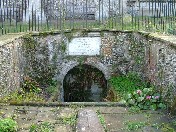 St. Withburga of
Dereham, Abbess of Dereham (Died AD 743)
St. Withburga of
Dereham, Abbess of Dereham (Died AD 743)
Withburga was the youngest of the saintly daughters of Anna, King of East
Anglia. Her sisters were SS. Ethedreda and Sexburga; they had an elder half-sister
St. Saethrith and an illegitimate half-sister, St. Ethelburga of Faremoutier-en-Brie. Withburga was also aunt of St. Ermengild
Withburga's Well - East Dereham
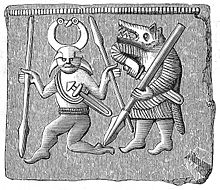 The outlaw in Northern European society held a unique position. Outlaws because they were largely expendable were used to commit deeds that no one else were willing to do. Often the outlaw though feared and hated found themselves in the role of hero.
The
Úlfhéðnar (singular Úlfhéðinn), mentioned in the Vatnsdla
saga,
The outlaw in Northern European society held a unique position. Outlaws because they were largely expendable were used to commit deeds that no one else were willing to do. Often the outlaw though feared and hated found themselves in the role of hero.
The
Úlfhéðnar (singular Úlfhéðinn), mentioned in the Vatnsdla
saga,
Haraldskvæði and the Völsunga saga, were said to wear the pelt of a wolf when they entered battle.[1] Úlfhéðnar are sometimes described as Odin's special warriors, with the pelt from a wolf and a spear as distinguishing features.[2] Modern scholars believe certain examples of berserker rage to have been induced voluntarily by the consumption of drugs such as the hallucinogenic mushroom Amanita muscaria, commonly known as the fly agaric or fly Amanita,[9] or massive amounts of alcohol.[10] While such practices would fit in with ritual usages, other explanations for the berserker's madness have been put forward, including self-induced hysteria, epilepsy, mental illness or genetic flaws.[11]
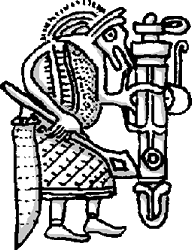 Wolf-warriors
(Ulfhednar) Beserkers
The etymology of the term *berserk* is disputed. It may mean "*bare*-sark,"
as in "bare of shirt" and refer to the berserker's habit of going
unarmored into battle. Ynglingasaga records this tradition, saying of the
warriors of Odhinn that "they went without coats of mail, and acted like
mad dogs and wolves"
Wolf-warriors
(Ulfhednar) Beserkers
The etymology of the term *berserk* is disputed. It may mean "*bare*-sark,"
as in "bare of shirt" and refer to the berserker's habit of going
unarmored into battle. Ynglingasaga records this tradition, saying of the
warriors of Odhinn that "they went without coats of mail, and acted like
mad dogs and wolves"
(Snorri
Sturluson. Heimskringla: History of the Kings of Norway. trans. Lee M.
Holander. Austin: U of Texas P. 1964. p.10).
...
Grettirs Saga calls King Harald's berserkers "Wolf-Skins," and
in King Harald's Saga they are called *ulfhedinn* or "wolf-coats,"
a term which appears in Vatnsdoela Saga and Hrafnsmal
(Hilda R. Ellis-Davidson,"Shape-Changing in the Old Norse Sagas, " in
Animals in Folklore. eds. J.R. Porter and W.M.S. Russell. Totowa NJ: Rowman and
Littlefield. 1978. pp. 132-133), as well as in Grettirs Saga (Denton Fox and
Hermann Palsson, trans. Grettir's Saga." Toronto: U of Toronto P. 1961. p.
3).
...
It is likely that the berserk was actually a member of the cult of Odhinn.
The practices of such a cult would have been a secret of the group's initiates,
although the Byzantine emperor Constantine VII refers in his Book of
Ceremonies to a "Gothic Dance" performed by members of his Varangian
guard, who took part wearing animal skins and masks: this may have been
connected with berserker rites Hilda R. Ellis-Davidson. Pagan Scandinavia. NY:
Frederick A. Praeger. 1967. p. 100). This type of costumed dance is also seen in
figures from Swedish helmet plates and scabbard ornaments, which depict human
figures with the heads of bears or wolves, dressed in animal skins but having
human hands and feet. These figures often carry spears or swords, and are
depicted as running or dancing. One plate from Torslunda, Sweden, may show the
figure of Odhinn dancing with such a bear figure.
...
The primary role of the berserk was as a warrior attached to a king's army.
Both King Harald and King Halfdan had berserker shock-troops. Aside from their
military value, the berserker's ties to Odhinn would have been welcome in a
royal army, since Odhinn also had a particular association with rulership,
being venerated in Anglo-Saxon England as the ancestor of chieftains, and
throughout the North as god of kings and protector of their royal power (Dumezil,
Gods of the Ancient Northmen, p. 26).
DYEING
SUTTON HOO NORDIC BLONDE: AN INTERPRETATION OF SWEDISH INFLUENCES ON THE EAST
ANGLIAN GRAVESITE
Images of the Wolf in the Northern Psyche - By
Heimgest, DCG
Then again, tales of noble, kindly wolves abound. All-Father
Odin is himself accompanied by two of the animals.
Byzantine emperor Constantine VII refers in his Book of
Ceremonies to a "Gothic Dance" performed by members of his Varangian
guard
Constantine VII Porphyrogennetos or Porphyrogenitus,
"the Purple-born"
(Greek:
Κωνσταντίνος
Ζ΄
Πορφυρογέννητος,
Kōnstantinos VII Porphyrogennētos), (September 2, 905
November 9, 959) was the son of the Byzantine
emperor Leo
VI and his fourth wife Zoe
Karbonopsina. He was also the nephew of the Emperor Alexander.
He is famous for his four descriptive books, De
Administrando Imperio, De
Ceremoniis, De
Thematibus and Vita
Basilii.
Varangians
- The Varangians served as the personal bodyguard[21]
of the emperor, swearing an oath of loyalty to him; they had ceremonial
duties as retainers and acclaimers and performed some police duties, especially
in cases of treason and conspiracy.
...
The Varangian Guard was only used in battle during critical moments, or
where the battle was most fierce.[22]
Contemporary Byzantine chroniclers note with a mix of terror and fascination
that the "Scandinavians were frightening both in appearance and in
equipment, they attacked with reckless rage and neither cared about losing blood
nor their wounds".[22]
The description probably refers to berserkergang
since this state of trance is said to have given them superhuman strength and no
sense of pain from their wounds
In the eleventh century, there were also two other European
courts that recruited Scandinavians:[15]
Kievan
Rus' c. 9801060 and London
10181066 (the Þingalið).[15]
Steven
Runciman, in The History of the Crusades, noted that by the time
of the Emperor Alexios
Komnenos, the Byzantine Varangian Guard was largely recruited from
Anglo-Saxons and "others who had suffered at the hands of the Vikings and
their cousins the Normans".
...
In 1088 a large number of Anglo-Saxons and Danes emigrated to the Byzantine
Empire by way of the Mediterranean.[5]
One source has more than 5,000 of them arriving in 235 ships. Those who did
not enter imperial service settled on the Black Sea coast, but those who did
became so vital to the Varangians that the Guard was commonly called the Englinbarrangoi
(Anglo-Varangians) from that point. In this capacity they fought in
Sicily against the Normans under Robert
Guiscard, who unsuccessfully sought to invade the lower Balkans as well.
Writing about the unit as it was in 1080, the chronicler and princess Anna
Komnene refers to these "axe-bearing barbarians" as being
"from Thule", likely a reference to the British Isles or Scandinavia
...
They were prominent in the defence of Constantinople
during the Fourth
Crusade (1203) . Of the role of the guard, then composed of the English
and Danes, it is said that "the fighting was very violent and there was
hand to hand fight with axes and swords, the assailants mounted the walls
and prisoners were taken on both sides".
Wolf
Cults -
That Greece had its own man-wolf cults (witness Lycaon, Tyrant of Arcadia
whence the word lycanthropy) is well-documented, but the pre-historical
Classical legend relating most closely to the MANNERBUND is that of the Luperci.
These were young men who gathered around Romulus and Remus, the founders of Rome
who had been brought up by a she-wolf on the banks of the Tiber.
Those deadly enemies of the Romans, the Germanic tribes east of the Rhine,
shared at least one similarity with the Imperium; their wolf-cults. Called
Ulfhednar (=wolf-skins, because that is what they wore), they were
composed of cult bands of warriors dedicated to Woden (Odin), who himself
keeps two wolves, Geri and Freki (=greedy).
As late as 930ce King Harald I Haarfager (=Fairhair) employed Ulfhednar as
his bodyguards. The Ulfhednar were not alone. Other Teutonic
warrior-fraternities that we still know about include the Boar-warriors (the
Sutton Hoo helmet found in East Anglia and now in the British Museum is crowned
with the image of a boar), who fought in wedge-shaped formations called
Svinfylking, and most famously of all the Berserkir (=Bear-shirts, from
whom we get they expression going beserk because thats what they
did in battle, usually naked).
These brutal MANNERBUND left their legacy to medieval Europe in heraldry and
in the names of their chiefs, later kings of the earliest European family of
nations. Bearskin hats are still worn by royal guards in Britain and Denmark.
Wulfing - The Wulfings, Wylfings or Ylfings[Note 1] (the name means the "wolf clan") was a powerful clan in Beowulf, Widsith and in the Norse sagas. While the poet of Beowulf never bothers to locate the Wulfings geographically (it was probably common knowledge), Scandinavian sources define the Ylfings (the Old Norse form of the name) as the ruling clan of the Eastern Geats.[1]
Sam Newton and others (including Rupert Bruce-Mitford), have proposed that the East Anglian Wuffing dynasty was derived from the Wulfings, and it was at their court that Beowulf was first composed.[2]
Geats - Geats (Old English Geatas, [ˈjæ͡ɑtɑs]; Old Norse Gautar, [ˈɡɑ͡utɑr]; Swedish Götar, [ˈjøːtar]), and sometimes Goths,[1]) were a North Germanic tribe inhabiting what is now Götaland ("land of the Geats") in modern Sweden. The name of the Geats also lives on in the Swedish provinces of Västergötland and Östergötland, the Western and Eastern lands of the Geats, and in many other toponyms
Sutton Hoo - The Evidence of the Documents (Beowulf)
A plausible account, drawn from the preceding discussion but put in a more categorical form than the data perhaps warrant, might run as follows:
A settlement of Wylfings from Ostergotland had arisen in East Anglia not long before
470. Whether it was tribal or purely dynastic it is hard to say. It was reinforced
by a second, perhaps limited, influx of important Geat exiles with Danish connections
who took refuge with their Wylfing kinsmen after the final overthrow
of the already weakened Geat kingdom a decade or two before the middle of the 6th century by the
barbarian Swedes.
Geats
- Until 1973 the official title of the Swedish king was King of the Swedes,
the Geats/Goths and the
Anglo-Saxons.net Timeline 450-512
The Ravenna Cosmographer, writing perhaps at the same time as Bede, says that the Saxons arrived in Britain led by their prince Ansehis. This name looks like a blundered Continental form of Æsc and suggests that in one version of the story it was Æsc, not Hengest and Horsa, who led the Saxons to Britain
Here we find an ancient village in Hertfordshire called TIW - TEWIN :
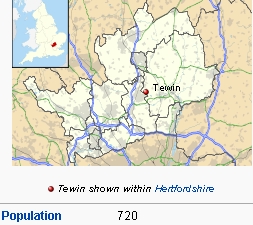 Tewin
- is a village in the British
county
of Hertfordshire,
between the towns of Welwyn
Garden City, Stevenage,
Welwyn
(village) and the county town Hertford,
it is within commuting distance of London.
The population of Tewin Parish was 1438 according to the 2001 census; Tewin
village has a population of approximately half that of the whole parish, 720.
Tewin
- is a village in the British
county
of Hertfordshire,
between the towns of Welwyn
Garden City, Stevenage,
Welwyn
(village) and the county town Hertford,
it is within commuting distance of London.
The population of Tewin Parish was 1438 according to the 2001 census; Tewin
village has a population of approximately half that of the whole parish, 720.
The village dates back, at least, to Anglo-Saxon times and its name has its origins in the English as spoken in that era.
Tewin is known to have been settled by the Angles in 449 AD; the name being a derivative of the Old English words for the Norse god Týr (Tiw) and meadow (Ing). However the name varies over the centuries - in the Domesday Book it is Tewinge and Theinge - and in the 16th century Tewinge, Tewing and Twying, but it is thought the village became Tewin in the 18th century.
Tewin is set in a rural landscape which retains many features characteristic of ancient countryside and which supports a wide variety of wildlife. The village contains areas set aside for the Hertfordshire and Middlesex Wildlife Trust which are managed by volunteers, these include Tewin Orchard and Hopkyns Wood Nature reserve.
Parishes - Tewin British History Online - The main road from Hitchin to Hertford runs parallel to the river, and to the north of this on the high ground the village is situated, connected with it by a branch road. ...
Tewin
In the time of King Edward the Confessor TEWIN was held by Aldene, a thegn of the
king.
After the Conquest, according to the statement of Aldene himself, King William regranted the manor to him and his mother 'for the soul of his son Richard.'
(fn. 2) This was William's second son, 'who was cut off in the New Forest by a sudden and mysterious stroke while the wearied stag was fleeing for its life before him.' (fn. 3)
Peter de Valognes the sheriff, however, maintained in 1086 that he held the manor of the gift of the king, and Aldene is recorded as holding it of
him. It was then assessed at 5½ hides. (fn. 4) The overlordship of Tewin descended in the Valognes family, and, being apportioned about 1240 to the youngest of the co-heirs Isabel Comyn, followed the descent of the manor of Sacombe in Broadwater Hundred (fn. 5) (q.v.).
By 1166 the lands of Aldene had become divided into two half-fees held respectively by Godfrey and Brian de Tewin. (fn. 6) Godfrey de Tewin's half-fee, which seems to be the manor of Tewin, descended to his son Richard before 1211, (fn. 7) and to Godfrey de Tewin, son of Richard, (fn. 8) by 1246. (fn. 9) This Godfrey de Tewin granted his lands or a part of them to Alexander de Swereford, baron of the Exchequer and treasurer of St. Paul's, apparently that he might grant them to the Prior and convent of St. Bartholomew, Smithfield. Godfrey confirmed them to the prior upon the death of Alexander, (fn. 10) and died leaving two sons, John, who was mesne lord of the manor in 1279 (fn. 11) and left a widow Amabel, and Guy, to whom the lands held by Amabel in dower reverted at her death. (fn. 12) This mesne overlordship seems to have died out on the death of Guy, for in 1303 the half-fee was held immediately of John Comyn by John Godefrei, Prior of St. Bartholomew, Roger de Louth, John de la Penne, and John the chaplain (Capellanus). (fn. 13) In 1347 the portion of Roger de Louth was conveyed to the prior by Richard de Burton and Roger de Creton. (fn. 14) In 1428 the half-fee was held by the prior and his coparceners. (fn. 15)
...
In 1278 the Prior of St. Bartholomew, Smithfield, claimed in Tewin, as in his other lands, sac and soc, thol and theam, flemenesfrith, frithsoken, mundbriche, miskennig, utlop (utlagh ?), wesgeldethef and hamsoken in breach of the peace, arson and bloodshed. He also claimed to be quit of tolls, sheriff's aid and shire and hundred courts, and to have view of frankpledge. (fn. 33) In 1287 he claimed and was allowed utfangentheof, infangentheof, flemenesfrith, gallows, amendment of the assize of bread and ale, and view of frankpledge. (fn. 34) Court leet and view of frankpledge were included in the grant to John Cock in 1544. (fn. 35) In 1086 there was one mill in Tewin, (fn. 36) which was later given with the manor to St. Bartholomew, Smithfield. (fn. 37) In 1368 two are mentioned, perhaps both under the same roof, for they were called 'la Solo.' (fn. 38) They were granted with the manor to John Cock in 1544. (fn. 39) The mill, which was on the River Mimram, was pulled down in 1911.From: 'Parishes: Tewin', A History of the County of Hertford: volume 3 (1912), pp. 480-487. URL: http://www.british-history.ac.uk/report.aspx?compid=43646 Date accessed: 01 January 2011.
The Spear Dance by Pete Jennings
The Sutton Hoo helm is of Anglo Saxon ownership, generally believed to belong to King Rædwald, who died around 625 CE, and thought to have been the occupant of the spectacular treasure ship burial there. It is possible the helmet was made for him by Swedish craftsmen. Another helmet fragment discovered in Caenby, Lincolnshire, shows further traces of similar ritual dancers, and could be directly related: King Rædwald defeated Æthelfrith of Northumbria near there, losing his son Rægenhere in the battle. I have noted that some spears are definitely pointing down in the illustrations - not the usual way to carry them if you are to avoid stabbing your feet.
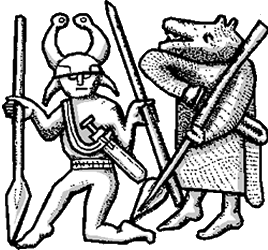
Wulfing - The Wulfings, Wylfings or Ylfings[Note 1] (the name means the "wolf clan") was a powerful clan in Beowulf, Widsith and in the Norse sagas. While the poet of Beowulf does not locate the Wulfings geographically, Scandinavian sources define the Ylfings (the Old Norse form of the name) as the ruling clan of the Eastern Geats.[1]
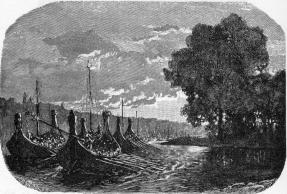 The
Wulfings play an important role in Beowulf
as Beowulf's
father Ecgþeow
of the Wægmunding
clan had slain one of its members, and was banished for not paying the wergild.
The Danish king Hroðgar,
who was married to Wealhþeow,
a Wulfing woman, graciously paid the wergild, and when Beowulf arrived at the Danish
court in order to slay Grendel,
Hroðgar interpreted this as a son's gratitude.
The
Wulfings play an important role in Beowulf
as Beowulf's
father Ecgþeow
of the Wægmunding
clan had slain one of its members, and was banished for not paying the wergild.
The Danish king Hroðgar,
who was married to Wealhþeow,
a Wulfing woman, graciously paid the wergild, and when Beowulf arrived at the Danish
court in order to slay Grendel,
Hroðgar interpreted this as a son's gratitude.
In Old Norse sources, the clan figure prominently in the Heimskringla and in Sögubrot, where Hjörvard and his son Hjörmund belong to it. It is also mentioned in the Lay of Hyndla and in Skáldskaparmál where Eiríkr the Wise was one of its members. However, its most famous member was Helge Hundingsbane who had two poems of his own (Helgakviða Hundingsbana I and Helgakviða Hundingsbana II), in the Poetic Edda, and whose story is also retold in the Völsunga saga.
Sam Newton and others (including Rupert Bruce-Mitford), have proposed that the East Anglian Wuffing dynasty was derived from the Wulfings, and it was at their court that Beowulf was first composed
According to the Norse sagas, the Wulfings ruled the Geatish petty kingdom of Östergötland.
An Anglo-Saxon verse-book - is an anthology in which the most representative and original parts of our earliest poetic literature are brought together. The selections are arranged under headings in accordance with their literary affinities, the idea of an organic whole being throughout emphasized. The anthology is intended to illustrate a course of study, whether private or in university lectures, of Anglo-Saxon self-expression in literature.
Wulf and Eadwacer - is an Old English poem of famously difficult interpretation. It has been variously characterised, (modernly) as an elegy, (historically) as a riddle, and (in speculation on the poem's pre-history) as a song or ballad with refrain. The poem's complexities are, however, often asserted simply to defy genre classification, especially with regard to its narrative content. The poem's only extant text is found within the 10th century Exeter Book, along with certain other texts to which it possesses qualitative similarities
The situation in Wulf and Eadwacer is far more typically Anglo-Saxon than as usually interpreted, if the speaker is understood to be the mother of the person she addresses as Wulf, as well as of the whelp of line 16."[1] This argument that Wulf is actually the narrators son gives a different depth to the elegyit becomes a poem of mourning for her son that seems to be exiled from her and their people. This idea has credibility when put in context that she was peace-weaved to Eadwacer, making Wulf their son.
Wulf and Eadwacer Translated
Anglo-Saxon Women - Cnut's law also specified that if a woman's husband died before they had any children, she was entitled to one-third of his land (called "dower," under common English law,) plus her morgegifu .... Some unmarried (usually upper class) women in Anglo-Saxon times inherited land at birth. This, of course, lead to many arranged marriages for land. Not only on the bride's side, but also the groom's. ...
Peace-Weavers - A specific type of arranged marriage was that of a peace-weaver ("fricwebba.")
The term "peace-weaver" means exactly what it says: it was the role of a woman (usually a noblewoman) to marry someone (usually a nobleman) from a rival tribe or clan to weave peace between the two groups.
Though not exactly portrayed in the greatest light through Anglo-Saxon literature, (peace-weavers are usually seen as doomed tragic figures who are depressed and weeping all the time,) peace-weaving queen was considered an ideal role for aristocratic women in Anglo-Saxon times. Peace-weavers had more power and influence than the average Anglo-Saxon woman. She is the sole means of linking two different tribes together. By marrying someone from a different tribe, she ideally has the power to bring peace to both tribes. And, in doing so, she is insuring a good future for her children, who are the physical proof of these two tribes coming together. They had the ability to influence decisions made by the king and act 'as intermediary between king and warrior, both politically and socially.'
The most important job of a peace-weaver is (obviously) to become a mother , just for the simple fact that having a child blends the bloodlines of the two tribes, physically making them one.
Perhaps the reason that peace-weaving is seen in such a negative light in Anglo-Saxon literature is the fact that there were so many wars. The Anglo-Saxons were a warrior-based people. There were wars constantly going on. Logic says that if a peace-weaver was doing her job correctly, there would be far less wars. Yet, peace-weaving was more of a job of tradition, whether or not peace was kept.
Widsith - is an Old English poem of 144 lines that appears to date from the 9th century, drawing on earlier oral traditions of Anglo-Saxon tale singing. The only text of the fragment is copied in the Exeter Book, a manuscript of Old English poetry compiled in the late 10th century containing approximately one sixth of all surviving Old English poetry. Widsith is located between the poems Vainglory and The Fortunes of Men. Since the discovery of the Exeter Book in 1076, it has been housed in the Exeter Cathedral in southwest England.
Tribes of Widsith - In Widsith, there is a long recital of people, clans and tribes who were known in the Germanic world of the 6th century.
Helm Wulfingum - Helm the Wulfings,
Widsith spoke, unlocked his word-hoard, he who had travelled most of all men through tribes and nations across the earth.
Often he had gained great treasure in hall.
He belonged by birth to the Myrging tribe.
Along with Ealhild, the kind peace-weaver, for the first time, from the Baltic coast,
he sought the home of Eormanric, king of the Ostrogoths, hostile to traitors.
The age of Sutton Hoo: the seventh century in north-western Europe By M. O. H. Carver
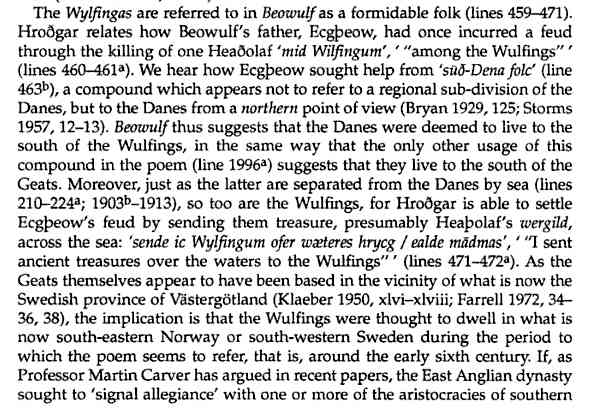
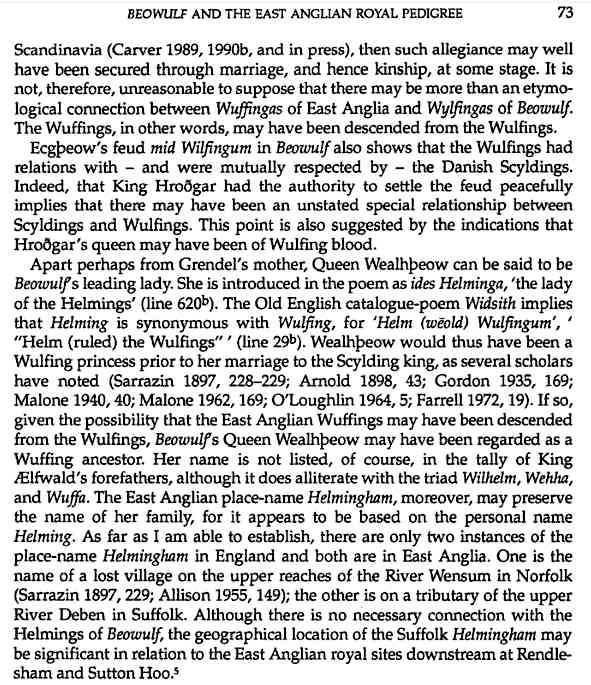
Echoes of the Lost Literature of the Wuffings at Sutton Hoo - Dr Sam Newton - Although an Old English genealogical poem concerned directly with the Wuffings has not survived, the existence of such a poem is indicated by a reference in the Passio of the late eighth-century East Anglian king and martyr, St Æthelbert.

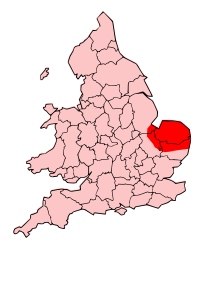 Thetford
Forest was created after the First World War to provide a strategic
reserve of timber, since the country had lost so many oaks and other
slow-growing trees as a consequence of the war's demands...Grimes Graves is
located within the forest.
Thetford
Forest was created after the First World War to provide a strategic
reserve of timber, since the country had lost so many oaks and other
slow-growing trees as a consequence of the war's demands...Grimes Graves is
located within the forest.
Thetford is traditionally thought of as the royal residence of Boudica Queen of the Iceni. The Iceni were a Celtic tribe living in Norfolk and parts of Cambridgeshire. ...In 1979, a hoard of Romano-British metalwork, known as the Thetford treasure was located just outside of Thetford
On February 19th 1998 Jean-Paul Davis, a French businessman working abroad in Ipswitch was offered a deal by a German gang leader importing wild animals such as wolves, tigers, bears and others into illegal zoos across the UK. Jean-Paul was in a bit of a pickle at this time with empty warehouses around the country including one in the middle of Thetford Forest. He was in a rut so when the gangsters made him an offer of 1,000,000 euros to hold 7 wolves for a week he felt obliged to accept. ...
Thetford forest under the Beasts rule - Mauled carcasses of deers and wild boars littered the forest floor but the
wolves remained under the radar despite the bones of Jean-Paul being discovered
by William Roads, Thetford forest park ranger. He said "I had seen nothing
like it, it didn't look human at all". The wolves stayed
undiscovered. Although they were playing a risky game as they were straying into
farm land and snatching the occasional pig. Farmers complained to the police but
the police ignored them.
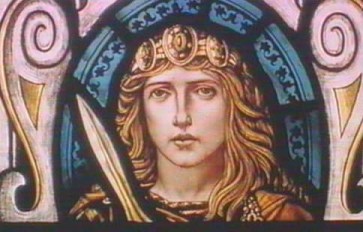 Queen
Boudica as portrayed in a stained glass window at Colchester town hall,
c.1901/02
Queen
Boudica as portrayed in a stained glass window at Colchester town hall,
c.1901/02
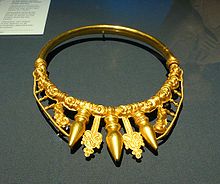 Tacitus
and Dio agree that Boudica was of royal
descent. Dio says that she was "possessed of greater intelligence than
often belongs to women", that she was tall, had long red hair down to
her hips, a harsh voice and a piercing glare, and habitually wore a large golden
necklace (perhaps a torc),
a many-coloured tunic, and a thick cloak fastened by a brooch.
Tacitus
and Dio agree that Boudica was of royal
descent. Dio says that she was "possessed of greater intelligence than
often belongs to women", that she was tall, had long red hair down to
her hips, a harsh voice and a piercing glare, and habitually wore a large golden
necklace (perhaps a torc),
a many-coloured tunic, and a thick cloak fastened by a brooch.
the Angles/Wuffing Migration 500-600AD:
...
A list of the kings of Angeln has been preserved in the Old English epic
poems, Beowulf (telling the story of a prince of the Geats) and
Widsith, both of which probably provided source material for the Anglo-Saxon
Chronicle. Some names were added in the seventh to ninth centuries by
chroniclers trying to make sense of the oral traditions they were writing down.
They seem to have been famous figures in their own right, existing in pre-migration
Frisia and Denmark.
...
Woden is claimed as an ancestor figure by many of the Anglian, Jutish and
Saxon tribes which later migrate to Britain. Is it possible that this
semi-mythical figure represents a powerful Anglian king whose many sons and
their descendants find or create positions of power as the Anglian peoples
fragment before and during their migration? Those claiming him as an ancestor
include the descendants of Baeldaeg, Benoc, Caser, Waegdaeg and Wehta, while the
kings of Lindsey claim direct descent from him.
Minor
Anglian, Jutish & Saxon Princes
Woden, legendary king of Angeln, is claimed as an ancestor figure by many of
the Anglian, Jutish and Saxon tribes which migrated to Britain. Although
entirely impossible to prove, one theory is that this semi-mythical figure
represents a powerful Anglian king whose many sons and their descendants found
or created positions of power as the Anglian peoples fragmented before and
during their migration.
...
Waegdaeg's Folk
One of the sons of Woden, king of Angeln,
Wægdæg was the originator of the line of princes which migrated to Britain
in the fourth to fifth centuries and created the Anglian kingdom of Deira based
on an existing British territory known as Deywr.
Wægdæg / Waegdaeg
Son of Woden of Angeln. Originator of the Deiran Angles.
Sigegar Son.
Swebdaeg Son.
Sigegeat Son.
c.420
Sæbald / Saebald Son. Led the Angles as laeti into Deywr?
c.420
Saebald apparently leads his people into Deywr in Britain to settle as
laeti. In 559, his descendant founds the independent Anglian kingdom of Deira.
|- - - - - -
Caser's Folk
One of the sons of Woden, king of Angeln, Caser was the originator of the
line of princes which migrated to Britain in the late fifth and early sixth
centuries and founded the Anglian kingdom of the East Angles.
Caser Son of Woden of Angeln. Originator of the East Angles.
Tyttman Son.
Trygil Son.
c.490s
Wealhtheow is the queen of the Danes, wife of Hrothgar. Her husband
appears in Norse Sagas and two Old English epic poems, Beowulf and Widsith,
while she is a Wulfing, ancestor (or mother) of the Wuffingas who, within
twenty years, are to be found creating their own kingdom of the East Angles in
Britain.
Hrothmund Son.
c.510s
Hrype Son. Probably in Britain.
c.530s
Wilhelm Son. Probably in Britain.
c.560s
Wehha Son. Possibly sowed the seeds of East Anglian consolidation.
571 - 578
Wuffa Son. United North and South Folk to form the East Angles.
571
Wuffa is the first acknowledged king of the East Angles, a kingdom that
is founded more than a century after the first coming of the Anglo-Saxon peoples
to Britain.
| - - - - - -
Teutonic mythology, Volume 4 By Jacob Grimm
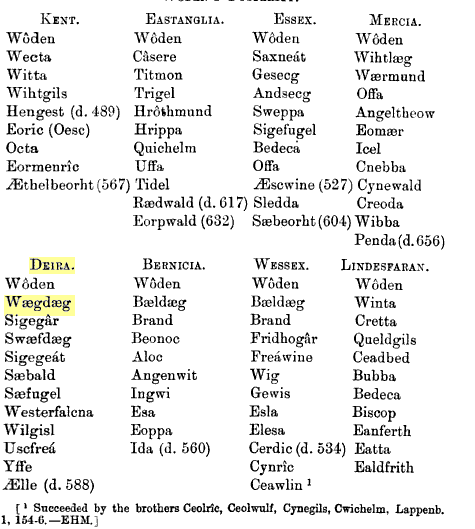
Early Anglian Grave found in Northumbria/Yorkshire:
Very Strong Men From England Greater Ancestors
...
December 24, 2011 :
In the year 1994 the bones of a giant man 7 feet tall, and a
woman over 6 feet tall were found near Thirsk Castle, England. Evidently
a population of Saxon giants once lived in the area:
http://www.thirskmuseum.org/giant.htm
http://yorkshire.greatbritishlife.co.uk/article/thirsk-enter-a-land-of-giants-and-curses-and-re-discover-this-north-yorkshire-market-town-22860/
Archaeologist Demands Respect for Giants Bones
Bones pointing to the existence of a community of Saxon giants in
north Yorkshire go on display next month despite a protest from the
archaeologist who found them.
The part-skeletons are an extraordinary find. Dug up from a
sixth-century Saxon cemetery discovered beneath the ruins of Thirsk Castle,
they indicate a seven-foot-tall man and a woman more than six
feet in height. A number of children were also buried there.
These bones could explain why there are quite a number of hefty Yorkshiremen
about, said Cooper Harding, curator at Thirsk Museum, where the remains will
be displayed.
You can imagine the terror of the native Celtic farmers, who were quite
short, when confronted by these giants.
But Leslie Webster, a curator at the British Museum, specialising in the early
Anglo-Saxon period, said last night: Saxons were not particularly tall.
These bones are certainly not normal. It would not be a normal height for any
period of British history.
The cemetery was discovered by archaeologist Anne Finney five years ago by pure
chance during a routine dig among the castle ramparts. But the artefacts have
been kept hidden from the public, stored in vaults and seen only by academics.
Ms Finney, who runs a firm called Map Archaeological Consultancy, handed them
over to the Yorkshire Archaeological Trust.
Thirsk Museum lobbied intensely for the bones and items of jewellery
including a stunning bronze cruciform brooch and early Saxon pottery to be
handed over and put on public display. It finally won after a five-year battle.
But Ms Finney is unhappy with the museums plans. It was a very good find.
But the bones should not be on display. You should treat human remains with
reverence.
Mr Harding said: Our display will be restrained and thoughtful. But as you
can see, it is the bones which capture the interest of the public.
[Source: The Independent / London / By Robert Mendick - March 12 2000 ]
\ - - - - -
Thirsk Castle
museum's Anglian Giant

The foot (above) and parts of a skull (below) were recovered during
excavations of a Saxon burial ground at Castle Garth, near the Museum.
Measurements of the leg bones show that the person stood
nearly seven feet tall. Thirsks Saxon Giant can be seen in
the Reynolds Room on the first floor of the Museum.
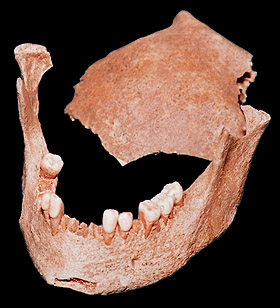
...
In the summer of 1994 an archaeological excavation took place on this part of
the site in connection with the installation of a sub-station by Northern
Electric. The dig revealed a hitherto undetected sixth-century burial site.
This discovery confirmed the belief that Thirsk existed as a settlement long
before the arrival of the Normans in the late 11th century.
When the Roman Legions were withdrawn from northern Britain in AD 402 there were
already people from the north-western part of Europe settled here as part of the
Roman army and as time went by they were joined by more immigrants from across
the North Sea.
The folk settling in Yorkshire were Angles rather than
Saxons and by AD 560 an Anglian chieftain called Aella
ruled over a north-eastern kingdom called Deira.
The graves found here belong to the first half of the sixth century and the
artifacts associated with them are in a typically Anglian style.
The archaeologists found that graves had been disturbed at a later date,
probably when the castle ditch was dug, but had not been robbed. From the
size of the bones found in one of the graves we know that the man buried there
stood about seven feet - well over two metres - tall. Were there giants in those
days?
Full details of the 1994 dig and the finds from the site can be found at Thirsk
Museum in Kirkgate.
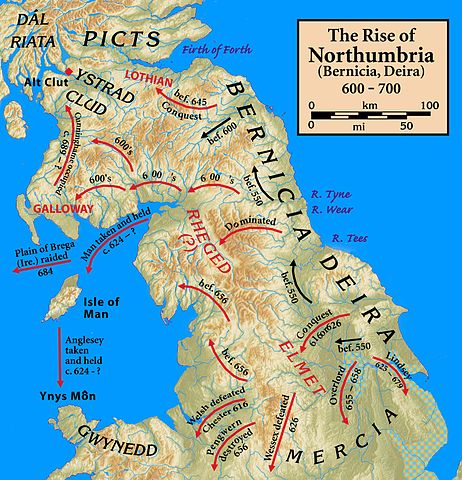 Deira
- (Old English: Derenrice or Dere) was a kingdom in Northern England which
probably emerged when Anglian warriors conquered the Derwent Valley in
the third quarter of the fifth century.[1] It extended from the Humber to the
Tees, and from the sea to the western edge of the Vale of York. It was the
southern of the two kingdoms of Deira and Bernicia which later merged to form
the kingdom of Northumbria.
Deira
- (Old English: Derenrice or Dere) was a kingdom in Northern England which
probably emerged when Anglian warriors conquered the Derwent Valley in
the third quarter of the fifth century.[1] It extended from the Humber to the
Tees, and from the sea to the western edge of the Vale of York. It was the
southern of the two kingdoms of Deira and Bernicia which later merged to form
the kingdom of Northumbria.
...
The first Anglian king of Deira of whom we have any record is Ælla, who
flourished in the later 6th century after conquering the realm from the Britons
in 581
Folklore Wolf Source - Among the Celts, wolves were considered to be powerful, but helpful animals. Legend says that Cormac, King of Ireland, was always accompanied by them. The God Cernunnos was pictured with a wolf.
In pre-Christian Europe the wolf was a popular clan totem. Many clans were accused of turning themselves into wolves at certain times of the year. The reality behind this is that these clans dressed in wolf skins and masks for certain religious rites.
In Britain, the month of
January was set aside for hunting Wolves. January was called Wolfmonat, or Wolf
Month...
At one time wolves were so common and dangerous in Britain that the month
of January was set aside for hunting them. January was called Wolfmonat, or Wolf
Month. Although wolves were exterminated in England in 1509, they could be
found in the mountains of Scotland and Ireland until the beginning of the 18th
century.
Earl Harold and the Wizards.
...
For in January's Famine,
In the New Year cold and barren,
Oft these beasts in hunger maddened,
With their teeth for warm blood thirsting,
Would attack the wary traveler.
Therefore did the Saxon fathers,
Name it at this time "Wolfmonat."
Cold and dreary month "Wolfmonat".
Tyr - God of war. He was the only god brave enough to put his hand in the Fenris- wolf's mouth so the gods could bind it. The wolf bit off his right hand. There is much debate about his lefthandedness. In the norse culture the right hand was given for a pledge, which could be why the right hand was placed in the wolf's mouth. It has also been noted, however, that the offering of the right hand is to show that it is free of weapons. A left handed person was sometimes considered evil because he could use a weapon with his left hand even though he shook with his right hand. Tuesday is named for Tyr who was known as Tiw, or Tiu, by the Anglo-Saxons.
Tribe of Benjamin - Biblical connections to Wolf cults , Left-handers and the Holy Grail / Templars :
Timeline of the Old Testament - Large Map showing Migrations of the LOST Ten Tribes of Israel after Captivity
Keith Hunt - The Tribe of BENJAMIN in Europe - According to Robert Graves, the Danaus myth records the arrival in the Peloponnesus of 'colonists from Palestine'. Graves states that King Bolus is in fact Baal, or Bel - or perhaps Belial from the Old Testament. It is also worthy of note that one of the clans of the Tribe of Benjamin was the clan of Bela....The sack of Jerusalem in A.D. 70, and the destruction of the Temple, prompted a massive exodus of Jews from the Holy Land. .... Certain Roman legions included contingents of Jewish slaves, who accompanied their masters all over Europe. ... Only in the last 50 years have the English history teachers come to admit the history preserved by the Welsh, is in the main very true.
Bloodlines - In
the New Testament there is no indication of the Magdalen's tribal affiliation.
In subsequent legends, however, she is said to have been of royal
lineage. And there are other
traditions that state specifically that she was of the Tribe of Benjamin.
Recall, for example, that the Magdalen was from the city of Magdala,
the "city of doves", where sacrificial doves were raised for the
worship of the Goddess.
The Benjamites, the "sons of Belial", of course, had
been worshipers of the Goddess, and their dispute with the other Tribes
of Israel may have been, in large part, an Goddess versus God war.
Ancient Knights Templar
- Joseph of Arimathea with 12 missionaries landed on the Isle of Britain in
62 AD.
Mary Magdalene with her children and some female companions took refuge at Rennes
le Chateau which is located in Arcadia. The same area that the Tribe of
Benjamin settled when they were exiled from Israel.
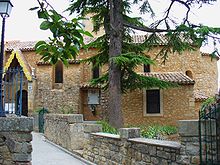 Sainte
Marie-Madeleine church Cathar Castles
Sainte
Marie-Madeleine church Cathar Castles
Mary Magdalene - In
Hebrew, "pillar" is a "M'GD'L" or "magdal."
So the name "Mary, the Magadalene" means "Mary the Pillar
(of her tribe)." She was the chief heir of the tribe of Benjamin.
To be left-handed or two-handed in The Scriptures
- Only one out of ten has this character - to be left-handed and
in all the generation there's seemed to be ambiguity about this character - some
said that people who are left-handed are like cripples ; some, on the
other side said that this is the ultimate warrior in the field, that can
fight with both of his hands without any difference.
Today we will speak about the left-handed or two handed figures from The Scriptures. First of all let us speak about one of the sneakiest judges from the people of Israel - Ehud Ben Gera, who was left-handed and won the battle with the Moabites after killing their king -Eglon.
"Again the Israelites cried out to the LORD, and he gave them a deliverer-Ehud, a left-handed man, the son of Gera the Benjamite"
Ehud was from the tribe of Benjamin, which was well-known of his left-handed warriors, who didn't miss any shooting as written in Judges 20:15-
"Among all these soldiers there were seven hundred chosen men who were left-handed, each of whom could sling a stone at a hair and not miss"
We are not sure if being left-handed was the character of this tribe from the genes or from practice and training. What we know fur sure is that being left-handed or two-handed, like Ehud and some his tribe were, gave you the advantage in the battle as written in 1 Chronicles 12:2-
"They were armed with bows and were able to shoot arrows or to sling stones right-handed or left-handed; they were kinsmen of Saul from the tribe of Benjamin"
The Twelfth Tribe of Israel
- the Tribe of Benjamin had been singled out for a very special and
exalted blessing, when in Deuteronomy 33:12, Moses pronounced blessings on the
patriarchs of each of the twelve tribes. Of
Benjamin, Moses said, "The beloved of the Lord shall dwell in safety by
him; and the Lord shall cover him all the day long, and he shall dwell
between his shoulders."
This symbolism later became a red cross between the shoulders.
This symbolism has carried down to modern times.
This 'red cross' has even been claimed as the origin of the Knights Templar
Ben Yamin of Asherah
- Notes on the Tribe of Benjamin, the Left Hand of Israel - Even in biblical times : Benjamin shall ravin [as] a wolf : in the
morning he shall devour the prey, and at night he shall divide the spoil.
The wolf is regarded by some as the totemic animal of the tribe (just as the
lion is for Judah).
...
Tribe of the Left Hand Path?
In Judaic mythology : The Tribe of Benjamin stood unique among the Tribes of Israel in certain respects. The only son born within the borders of Canaan, Benjamin was also, therefore, the only son of Jacob not joining Jacob-Israel in making a symbolic, and perhaps prophetic, bow before Esau and his four-hundred warriors upon their return to the land of Canaan.
Rachel had died giving birth to him. As she was dying
she named him "Benoni", meaning "son of my sorrow", but this name was changed to "Benjamin", meaning "son of the right hand" by Jacob afterwards.
This might have been as a result of Benjamin as a small boy lifting his left hand to Jacob's right hand when learning to
walk. The left hand was not the one generally used for such contacts as it was, by convention, reserved to the less-sanitary requirements of life, and thus the act would be noted. Curiously, Scripture mentions of
Benjamin's descendants, a number of these notable for the characteristic of being
left-handed.
...
Another connection is also made by others(?) through the alleged totemic
animal of the Danaans (the Greek name for the Hellenic Argives
descended from Danaos) and of the Benjaminites which is said to have been the
wolf (linking in the obvious Hebraic connotations of the names Daniel and
Belial).
What tribe did King Saul, the first king of Israel, come from ? - When Israel (Jacob) blessed his son Benjamin he compared him to a wolf that would go on tearing at his prey (Genesis 49:27) and the blessing was prophetic because the Benjaminites, though a small tribe, were known for being fearless and skillful fighters
Temple of Sakkara - The Magdalene, Knights Templar and Alchemy - The Mary Magdalene was an advanced healer and a highly respected member of the twelfth tribe of Israel, the Tribe of Benjamin. ...
Tribe of Dan and the Red Haired Race
- King Dan I (ODIN) commenced his reign in Scandinavia in the year 1040 B.C.
and his family line was known to have stretched back to Troy.
O-DIN is a title indicative of Kingship or Shepherd lineage. (Also known
as WO-DEN, WO-TAN and DAN)
ODIN comes from the Hebrew ADONAI which means "LORD".
The families descended from ODIN derive from the ancient Trojan
Kings.
...
"Accepting these sources," notes the magazine, "the royal
families of the NORTHERN NATIONS OF EUROPE -- Irish-Scottish, Early British,
Frankish, Norwegian -- are all of the SCEPTRE TRIBE OF JUDAH and the many
intermarriages of these royal lines would thus all be within the one great royal
family of which so much is prophesied in Scripture.
Queen Elizabeth II has stated that she is WODEN-BORN" (Dec. 1981.
Christian Israel Foundation, Walsall, England. P. 117).
Why is the tribe of Dan NOT LISTED in Revelation with the other tribes of Israel - We don't know. That is, we're left with guessing why the enumeration of the tribes in Revelation 7 is different from the standard listing given in the Old Testament.
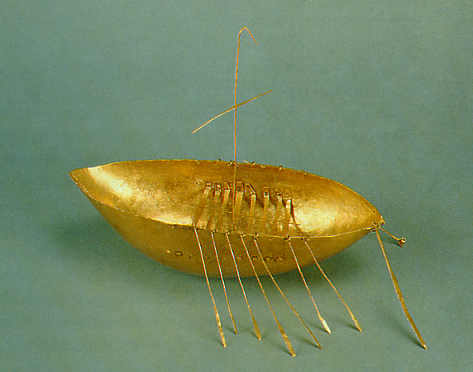 A gold ship model from 1st century
BC Broighter, Ireland.
A gold ship model from 1st century
BC Broighter, Ireland.
The History of the Red Haired Race - Tuatha De Danaan ... The records from ancient Ireland describe a whole series of invasions. The "Lebor Gabala Erren" ("The Book of the Taking of Ireland"), compiled during the 12th century A.D. describes the coming of the mysterious Tuatha de' Danann or Tribe of Danu.
They were apparently tall, blond or red-haired strangers, "expert in the arts of pagan cunning", who supposedly interbred with the locals, while teaching them many kinds of useful skills.
Although no one knows for certain what the Tuatha looked like, descriptions, such as of their female war-leader Eriu, indicate tall attractive people with pale skin, high foreheads, long red hair and large blue eyes.
Jacob - In the Hebrew Bible, he is the son of Isaac and Rebekah, the grandson of Abraham and Sarah and of Bethuel, and the younger brother of Esau. 32 and several daughters, by his two wives, Leah and Rachel, and their maidservants, Bilhah and Zilpah. The children were Reuben, Simeon, Levi, Judah, Dan, Naphtali, Gad, Asher, Issachar, Zebulun, daughter Dinah, Joseph, and Benjamin.
NOVA Online Lost Tribes of Israel - Where are the Ten Lost Tribes - Ever since the Assyrians exiled the Lost Tribes of Israel in the eighth century B.C., the mystery of what happened to the ten tribes has deepened inexorably with time. Where did they go? Are the claims by contemporary groups who say they are descended from the Lost Tribes legitimate? Here, we present an abbreviated history of the Lost Tribes and modern-day claims of descent. Excerpted with permission from Beyond the Sambatyon: The Myth of the Ten Lost Tribes, a CD-ROM released by MAXIMA New Media in 1995. (For more information on the CD and an accompanying book, see Resources.)
America in Bible prophecy -
The Paradoxical Tribe of Benjamin - This new article highlights a little known characteristic
of the sometimes smallest Tribe of ancient Israel. It supports the view that the modern identity of its
descendants today, are the people whom Bible prophecy expert Herbert W Armstrong said they mainly are:
Norwegians and Icelanders. by Geoffrey R. Neilson
The 'Varus' Film Project The Germanic warriors
Half-Naked Savages
That the early Germanics used both long spears and shorter frameae is fairly clear, but my point was that Germanicus' speech in Tacitus is sometimes cited as evidence that these longer spears were the norm, while the Germania passage actually indicates quite the opposite.
The question of whether the naked or half-naked appearance of Germanic (and Celtic) warriors is a Classical topos is an interesting one.
There are certainly many Classical descriptions of Celtic warriors fighting naked or half-naked, as these descriptions from Polybius, Diodorus Siculus and Strabo show. And
these are describing Celts in Gaul and the Alps, so I doubt this nakedness is due to the warmth of the weather. Depictions of Celts on Roman coins (eg a denarius of L. Hostilius Saserna) and other iconographic evidence also supports the idea that the early Celts sometimes fought in this way, so it's not unreasonable that their Germanic neighbours did as well.
In the later North Germanic tradition there was the concept of the berserkr - a name which may mean 'bear shirt', ie a shape-shifter who takes the form of a bear in battle, or
'bare-sark' or someone who goes into battle without a shirt due to battle rage.
Images of humans are relatively rare in Germanic art and even then they are usually stylised to the extent that details, such as whether they are clothed or not, are hard to discern.
But this sixth century helmet plate die from Torslunda apparently depicts the god Tyr/*Tiwaz in his encounter with the wolf Fenris and shows him half-naked:
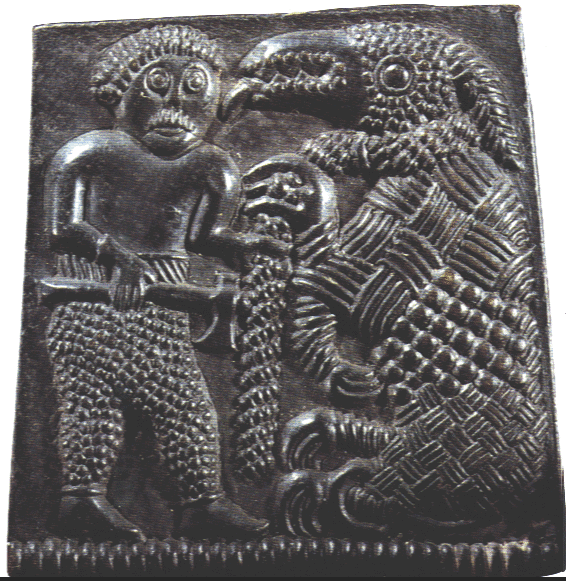
Given the descriptions in Tacitus of Germanic warriors fighting only in a cloak and various depictions of naked and half-naked Germanics on Roman monuments -
Trajan's Column springs to mind - I'd say this concept has its origin in observation rather than literary convention.
Classical Descriptions:
Polybius History [2nd century BC].
Note. The following three passages describe the Battle of Telamon in Etruria
(northern Italy) which took place in 225 BC.
¶ 2.28.3-I0. THE CELTS HAD STATIONED THE GAESATAE 'Spearmen from the
Alps to face Aemilius on the rear, and behind them were the Insubres. On their
front they placed the Taurisci and the CisaIpine Boii to face the Romans. They
placed their waggons and chariots on the edges of both wings, with the booty
being on one of the hills near the road under guard. Thus the Celtic army was
double-faced. Their way of arranging their forces was effective as well as
designed to inspire fear in their enemies. The Insubres and Boii were clothed
in pants and light cloaks, but the Caesatae from conceit and daring threw their
clothing off, and went out to the front of the army naked, having nothing but
their weapons. They believed that since the ground was covered with brambles
which might catch their clothing and hinder the use of their weapons, they would
be more effective this way.
¶ 29.5-9. But the Romans, while pleased to have trapped the enemy between two of their own armies, were greatly disturbed by the ornaments and battle noise of the Celts. For there were among them countless horns and trumpets which were being blown simultaneously from every part of the army. The sound was so loud and piercing that the clamour didn)t seem to come from trumpets and human voices, but from the whole country-side all at once. Also terrifying was the appearance and rapid manoeuvring of the naked warriors in front, men at the prime of their strength and magnificence. And all the warriors in front were wearing torques and bracelets. All these sights terrified the Romans, but hope of victory encouraged them to try even harder in the battle.
Diodorus Siculus [c. 60-30 BCE]
¶ 28. The Gauls are very tall with white skin and blond hair, not only blond by nature but more so by the artificial means they use to lighten their hair. For they continually wash their hair in a lime solution, combing it back from the forehead to the back of the neck. This process makes them resemble Satyrs and Pans since this treatment makes the hair thick like a horse's mane. Some shave their beards while others allow a short growth, but nobles shave their cheeks and allow the mustache to grow until it covers the mouth. The result is that their mustaches become mixed with food while they eat, but serve as a sort of strainer when they drink. They do not sit in chairs when they dine, but sit on the ground using the skins of wolves or does. While dining they are served by adolescents, both male and female. Nearby are blazing hearths and cauldrons with spits of meat. They honour the brave warriors with the choicest portion, just as Homer says that the chieftains honoured Ajax when he returned having defeated Hector in single combat. They also invite strangers to their feasts, inquiring of their identity and business only after the meal.
During feasts it is their custom to be provoked by idle comments into heated disputes, followed by challenges and single combat to the death. They do not fear death, but subscribe to th'e docfrine of Pythagoras that the human spirit is immortal and will enter a new body after a fixed number of years. For this reason some will cast letters to their relatives on funeral pyres, believing that the dead will be able to read them.
¶ 29. In both journeys and battles the Gauls use two-horse chariots which carry both the warrior and charioteer. When they encounter cavalry in battle they first hurl their spears then step down from the chariot to fight with swords. Some of them think so little of death that they fight wearing only a loincloth, without armour of any kind. They use free men from the poorer c!asses as charioteers and shield-bearers in battle. When two armies are drawn up for battle, it is their custom to step before the front line and challenge the best of their opponents to single combat while they brandish their weapons in front of them to intimidate the enemy. When an opponent accepts their challenge, they recite the brave deeds of both their ancestors and themselves, at the same time mocking the enemy and attempting to rob him of his fighting spirit. They decapitate their slain enemies and attach the heads to their horses' necks. The blood-soaked booty they hand over to their attendants, while they sing a song of victory. The choicest spoils they nail to the walls of their houses just like hunting trophies from wild beasts. They preserve the heads of their most distinguished enemies in cedar oil and store them carefully in chests. These they proudly display to visitors, saying that for this head one of his ancestors, or his father, or he himself refused a large offer of money. It is said that some proud owners have not accepted for a head an equal weight in gold, a barbarous sort of magnanimity. For selling the proof of one's valor is ignoble, but to continue hostility against the dead is bestial.
¶ 30. The Gauls wear stunning clothing shirts which have been dyed in various colours, and trousers which they call bracae. They also wear striped cloaks with a checkered pattern, thick in winter and thin in summer, fastened with a clasp. They use uniquely decorated, man-high shields in battle, some with projecting bronze animals of superb workmanship. These animal-figures serve for defensive purposes as well as decoration. Their helmets have large figures on top -- horns which form a single piece with the helmet, or the heads of birds and four-footed animals -- which give an appearance of added height to the warrior. Their trumpets are also of a peculiar and barbaric kind which produce a harsh, reverberating sound suitable to the confusion o battle. Some use iron breast-plates in battle, while others fight naked, trusting only in the protection which nature gives. They do not use short swords, but prefer a longer variety which are hung on their right sides by chains of iron or bronze. Some wear gold or silver-plated belts around their tunics. Their spears, called lanciae, have iron heads a cubit [18 inches] or more in length and slightly less than two palms in width. Their swords are as long as the spears of other peoples, and their spears have heads longer than others' swords. Some of the spears have straight heads, but others are twisted in their entire length so that a blow not only cuts but mangles the flesh and withdrawal tears the wound open.
Extracts are from The Celtic Heroic Age, by JT Koch and J. Carey, 1997
Dacians - were an Indo-European people, very close or part of the Thracians. Dacians were the ancient inhabitants of Dacia (located in the area in and around the Carpathian Mountains and east of there to the Black Sea). This area includes the present-day countries of Romania and Moldova, as well as parts of Sarmatia (mostly in eastern Ukraine), Moesia (Eastern Serbia, Northern Bulgaria), Slovakia[3] and Poland. They spoke the Dacian language, believed to have been closely related to Thracian, but were culturally influenced by the neighbouring Scythians and by the Celtic invaders of the 4th century BC
Wolf Mythology/Religion:
Romanian historian of religions Mircea Eliade attempted, in his book "From Zalmoxis to Genghis Khan", to give a mythological foundation to an alleged special relation between "Dacians and the wolves"[45]:
Keltoi = Celts
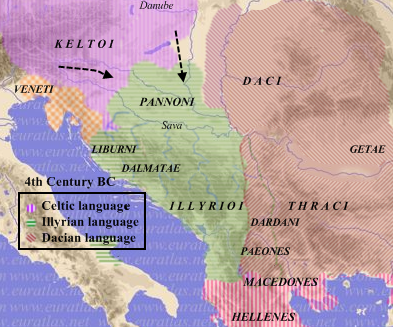 During
the second half of the 4th century BC, Celtic cultural influence appears in the
archaeological records of the middle Danube, Alpine region, and north-western Balkans,
where it figured the Middle La
Tène material culture. This material appears in north-western and
central Dacia and is reflected especially in burials [142].
The Dacians absorbed the Celtic influence that came down from the northwest
in the early third century BC [146].
Archaeological investigation of this period has highlighted several Celtic
warrior graves with military equipment. It suggests the forceful
penetration of a military Celtic elite within the region of Dacia, now known as
Transylvania, bounded on the east by Carpathian range.[142]
The archaeological sites of the third and second centuries BC from Transylvania
revealed a pattern of co-existence and fusion between the bearers of La Tène
culture and indigenous Dacians. These were domestic dwellings with a mixture of
Celtic and Dacian pottery and several graves of the Celtic type containing
vessels of Dacian type.[142]
There are some seventy Celtic sites in Transylvania but in most, if not all of
these sites (they are usually cemeteries; there were very few settlements) the
finds show that the native population imitated Celtic art forms that took their
fancy, but remained obstinately and fundamentally Dacian in their culture
During
the second half of the 4th century BC, Celtic cultural influence appears in the
archaeological records of the middle Danube, Alpine region, and north-western Balkans,
where it figured the Middle La
Tène material culture. This material appears in north-western and
central Dacia and is reflected especially in burials [142].
The Dacians absorbed the Celtic influence that came down from the northwest
in the early third century BC [146].
Archaeological investigation of this period has highlighted several Celtic
warrior graves with military equipment. It suggests the forceful
penetration of a military Celtic elite within the region of Dacia, now known as
Transylvania, bounded on the east by Carpathian range.[142]
The archaeological sites of the third and second centuries BC from Transylvania
revealed a pattern of co-existence and fusion between the bearers of La Tène
culture and indigenous Dacians. These were domestic dwellings with a mixture of
Celtic and Dacian pottery and several graves of the Celtic type containing
vessels of Dacian type.[142]
There are some seventy Celtic sites in Transylvania but in most, if not all of
these sites (they are usually cemeteries; there were very few settlements) the
finds show that the native population imitated Celtic art forms that took their
fancy, but remained obstinately and fundamentally Dacian in their culture